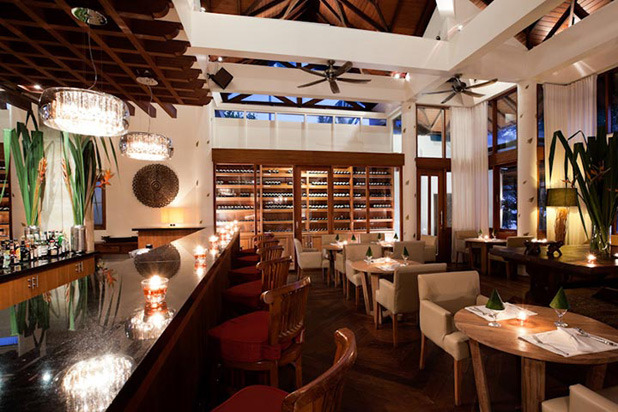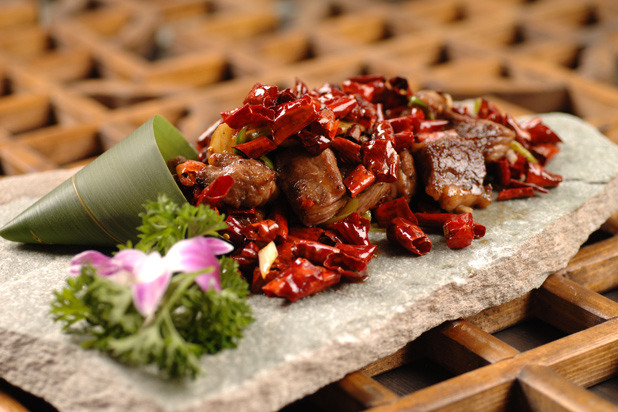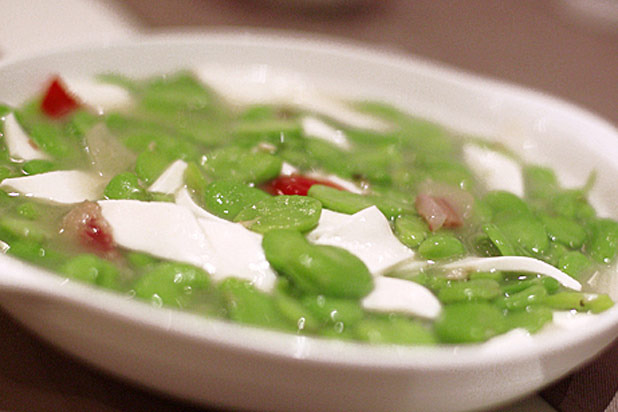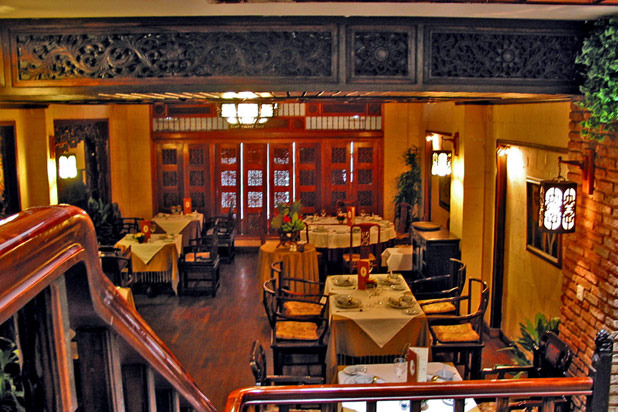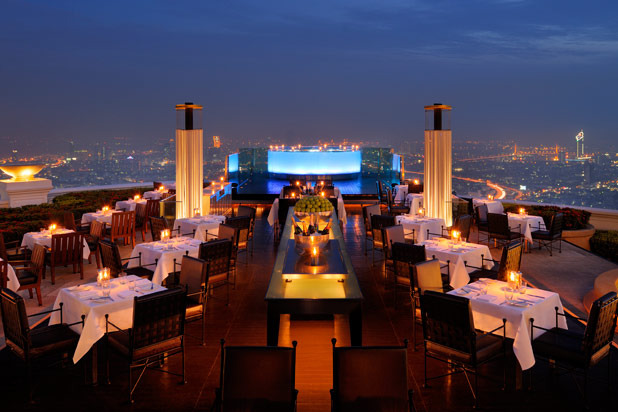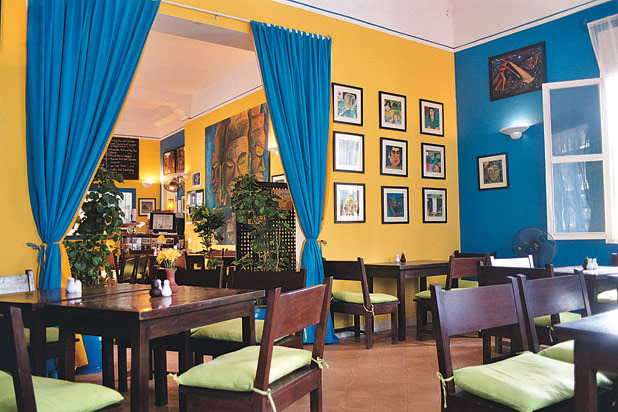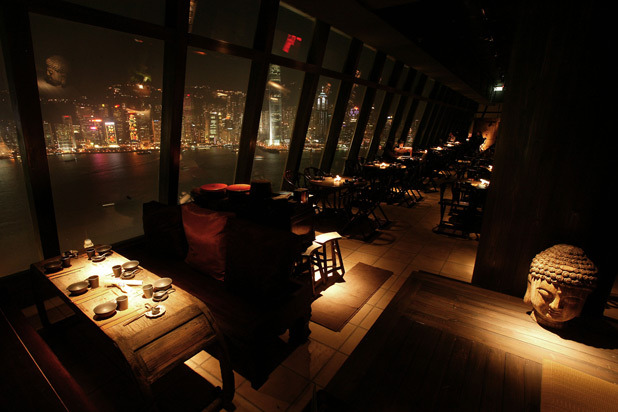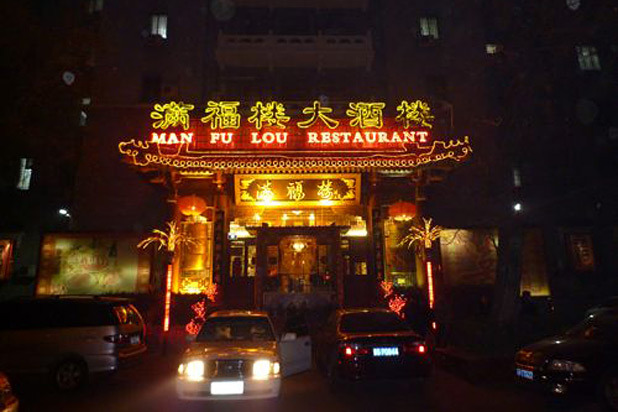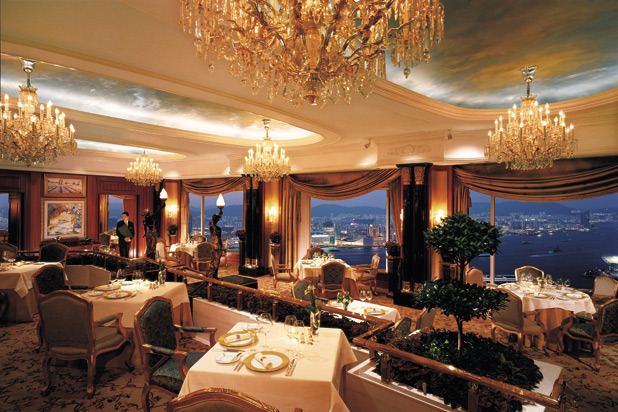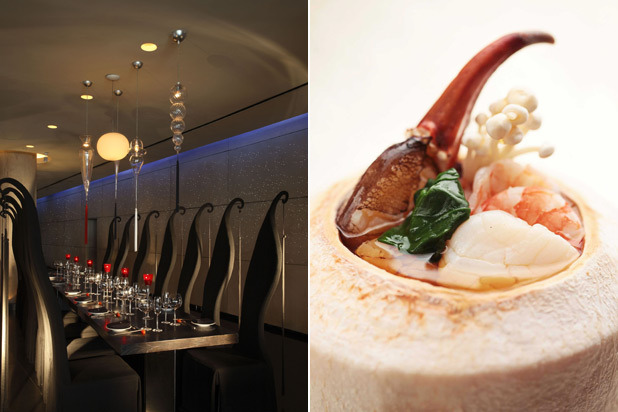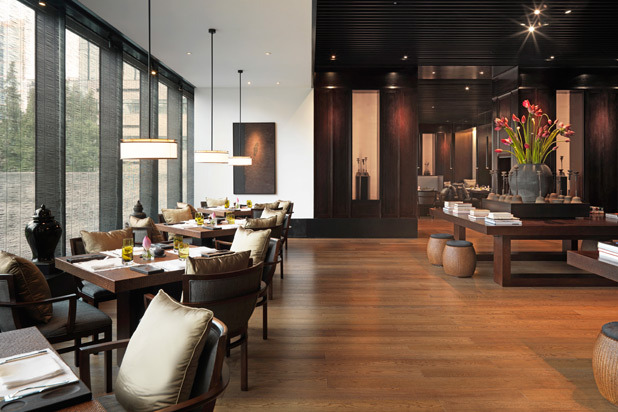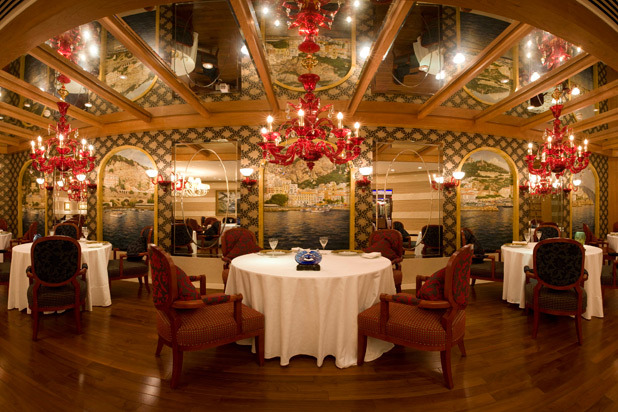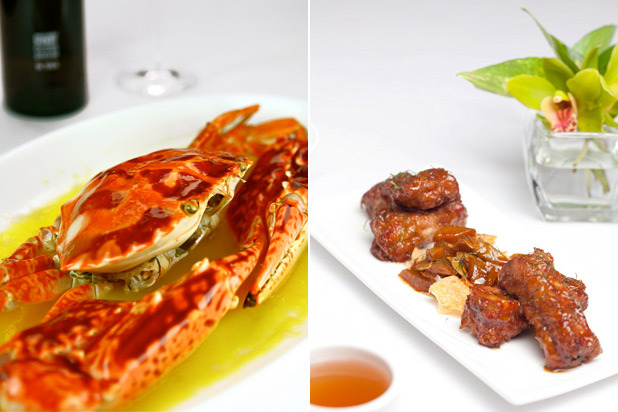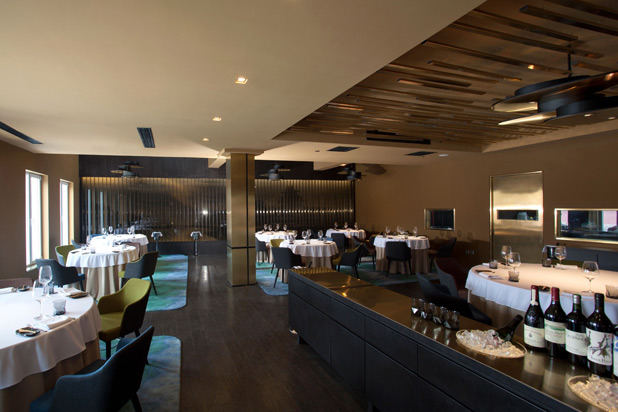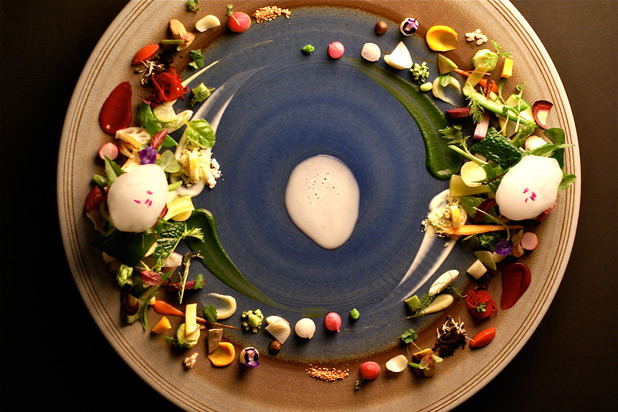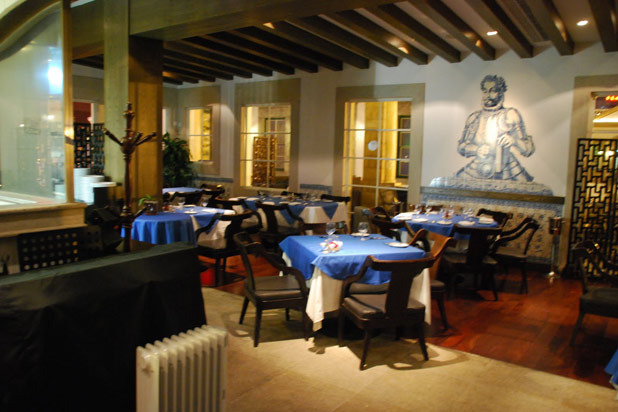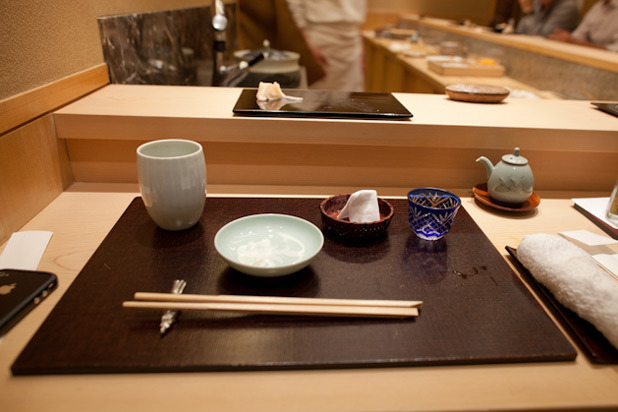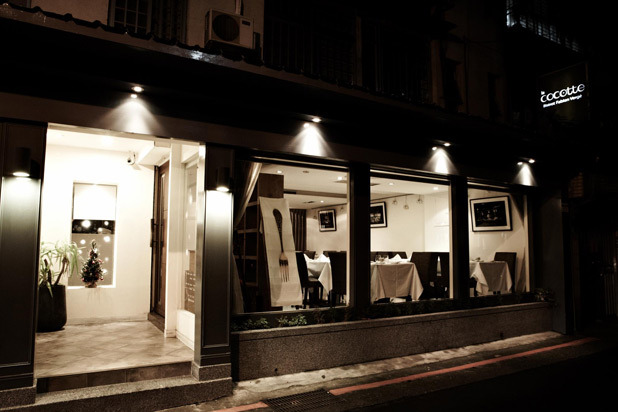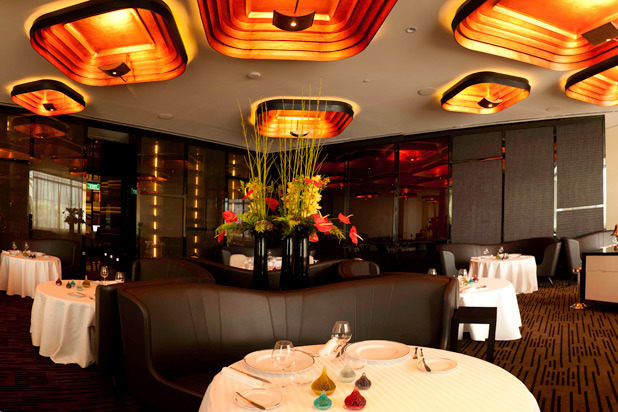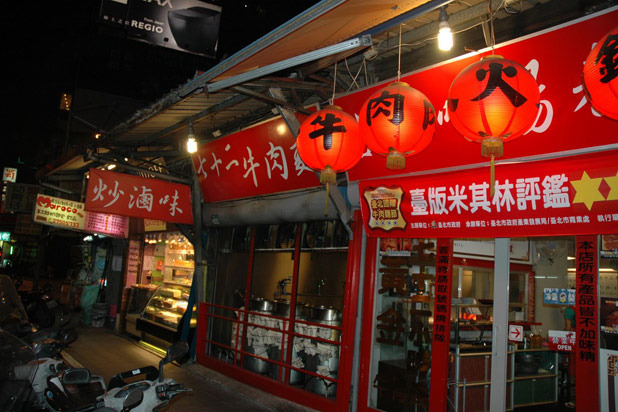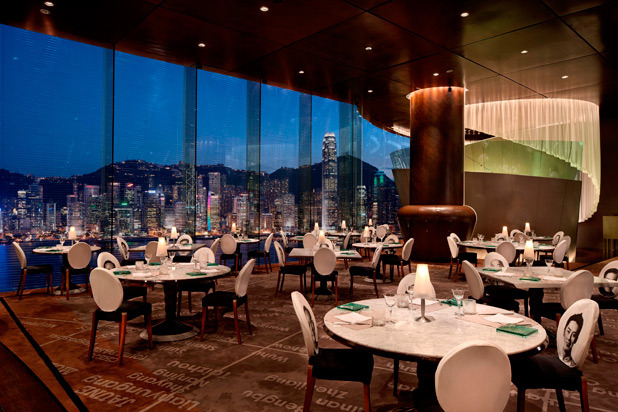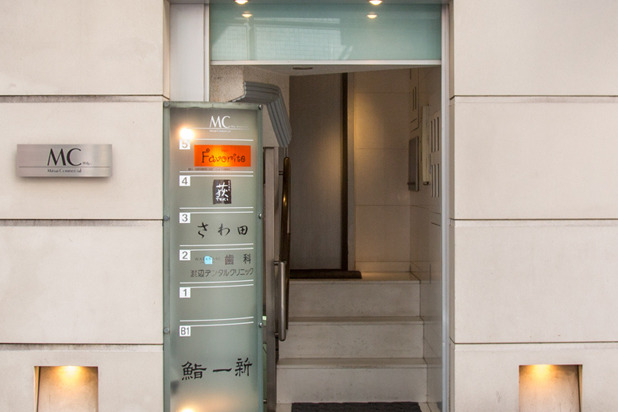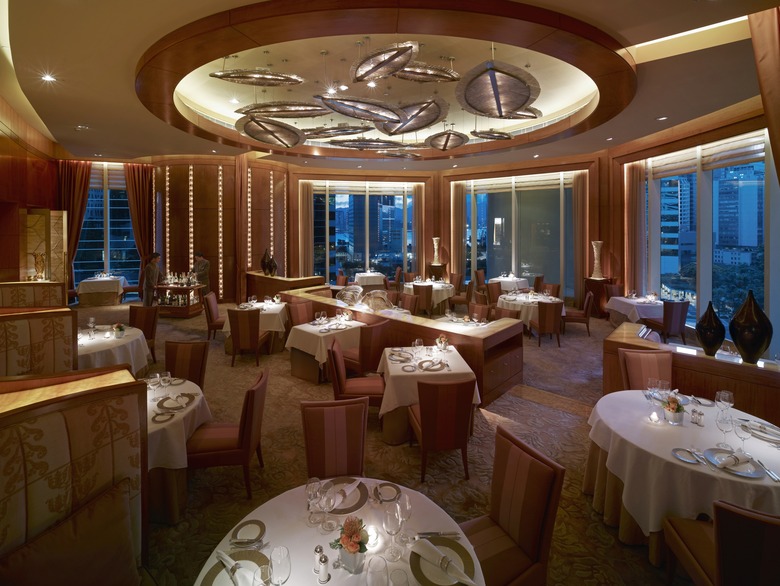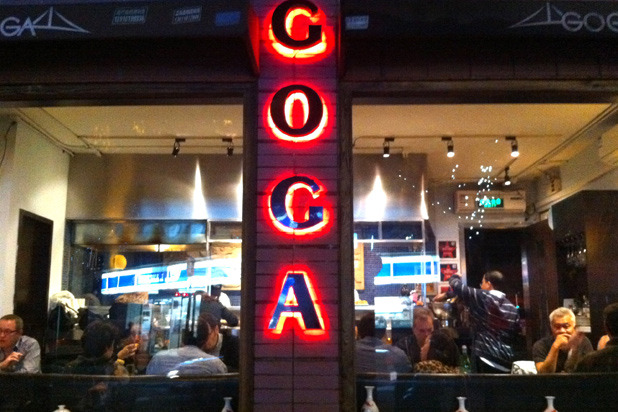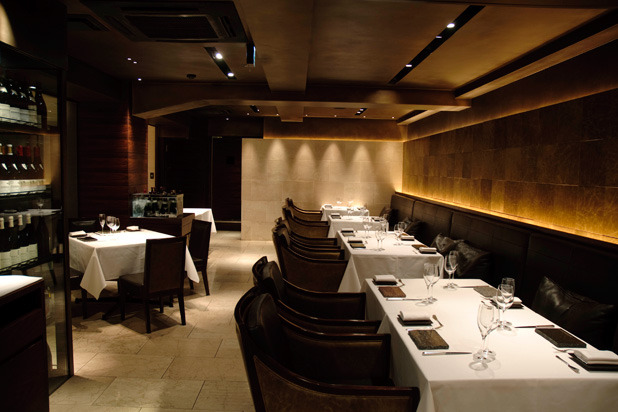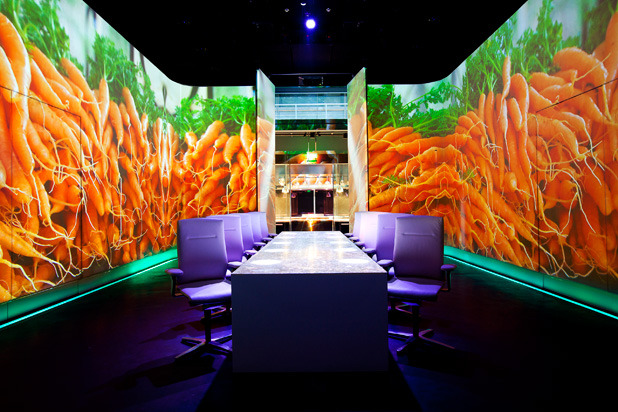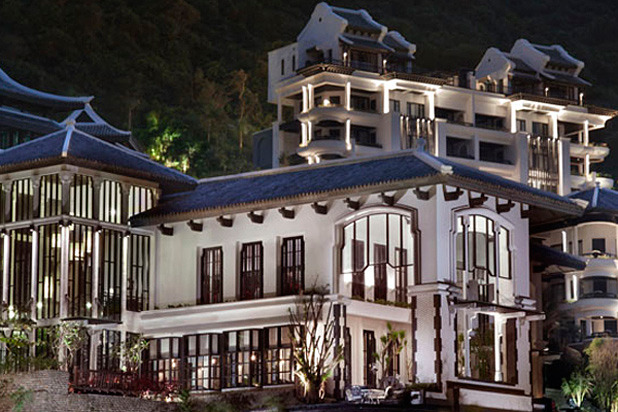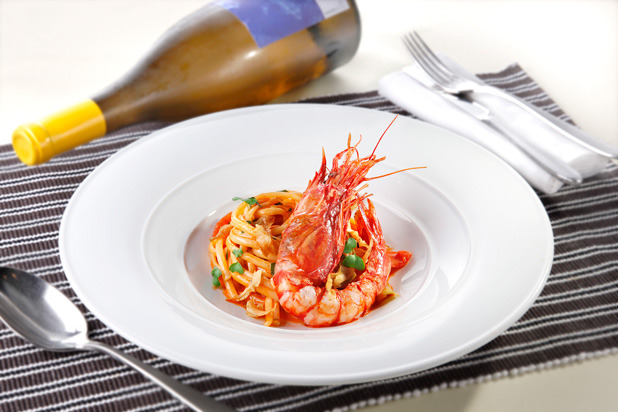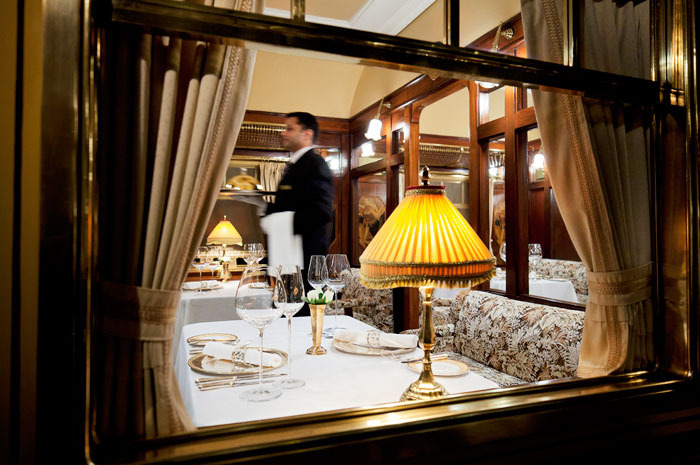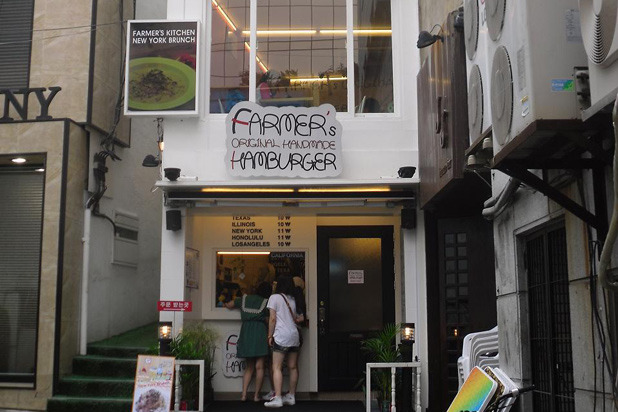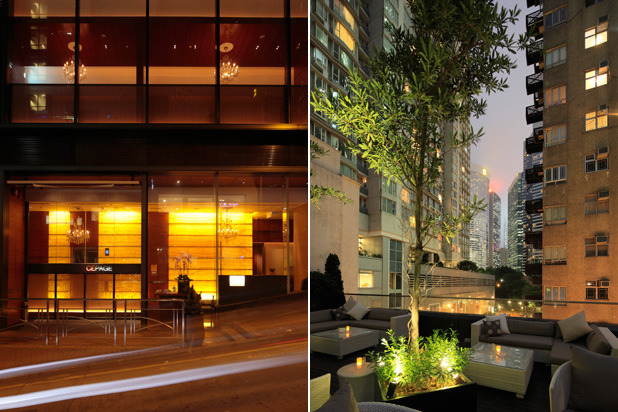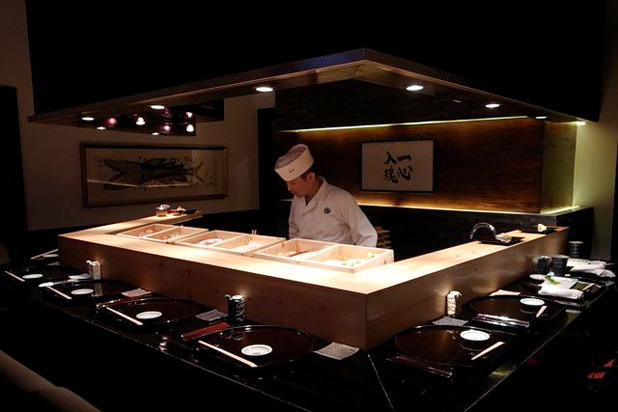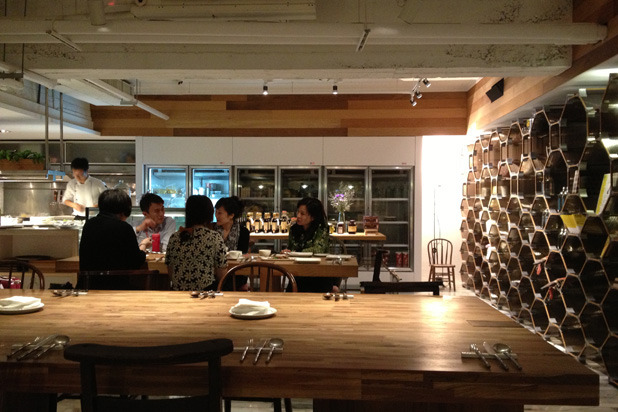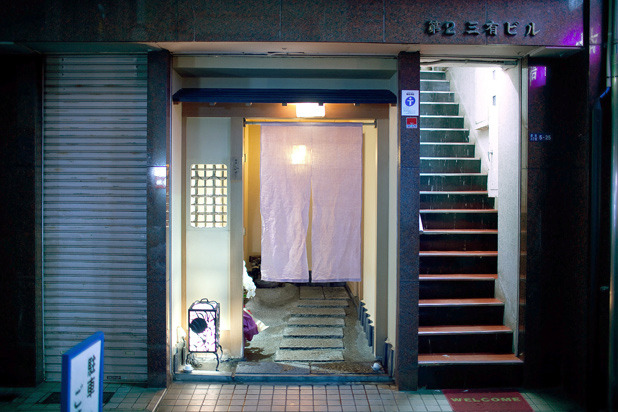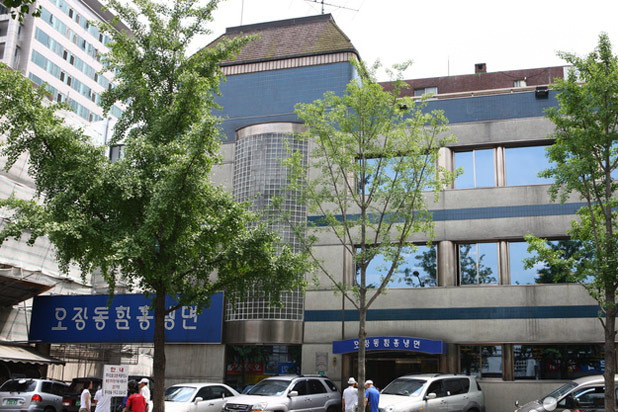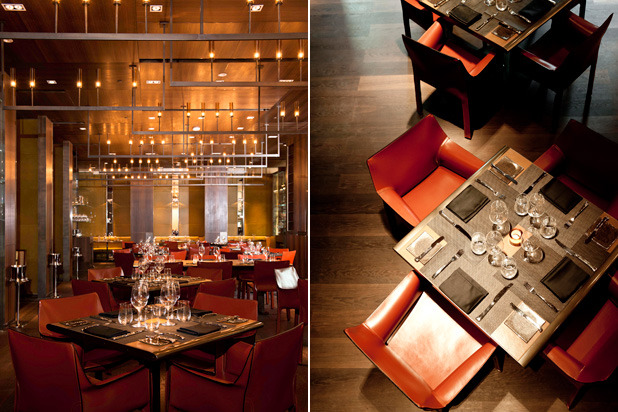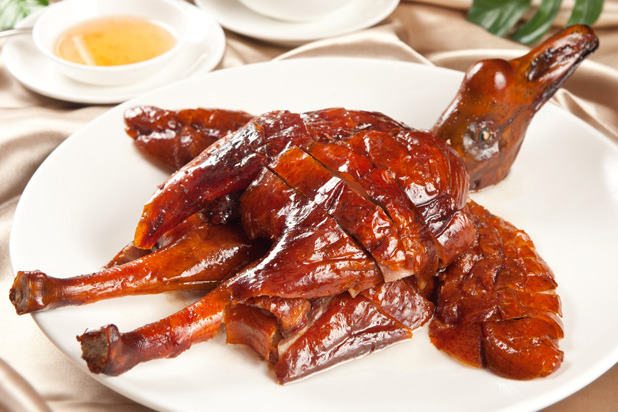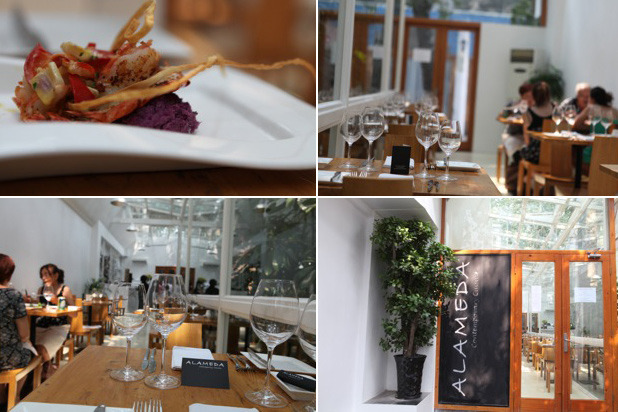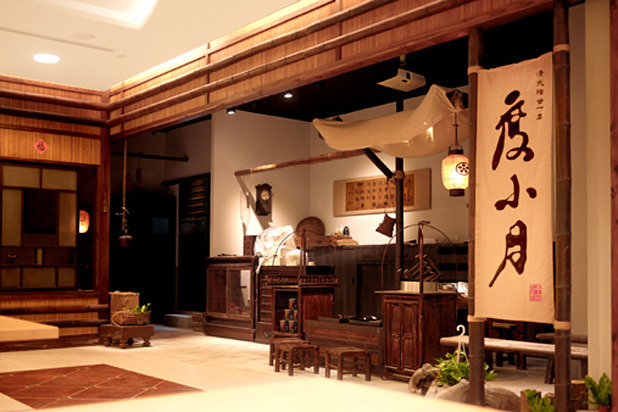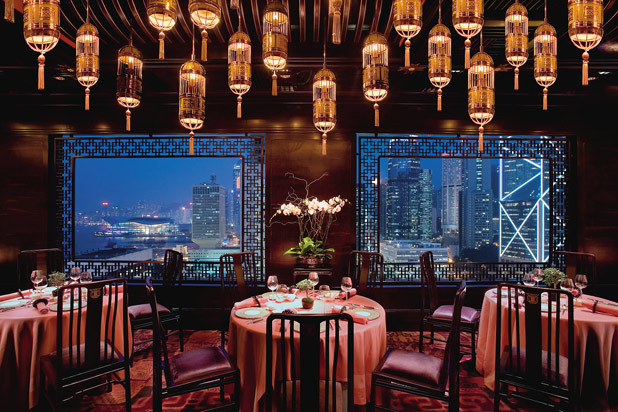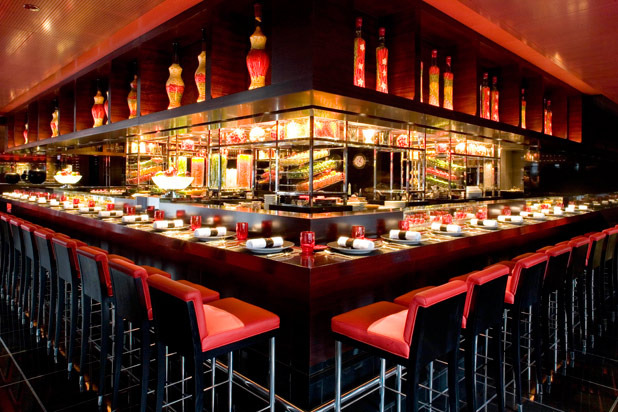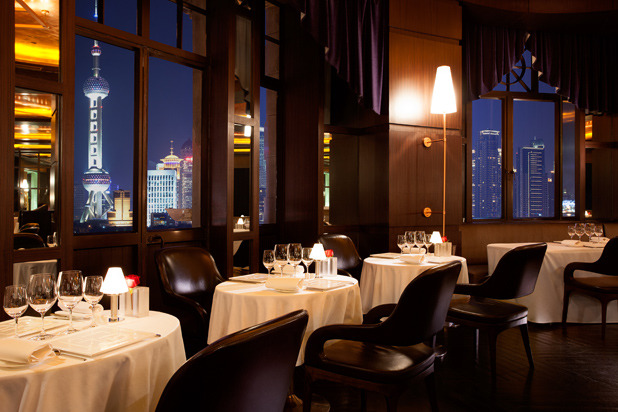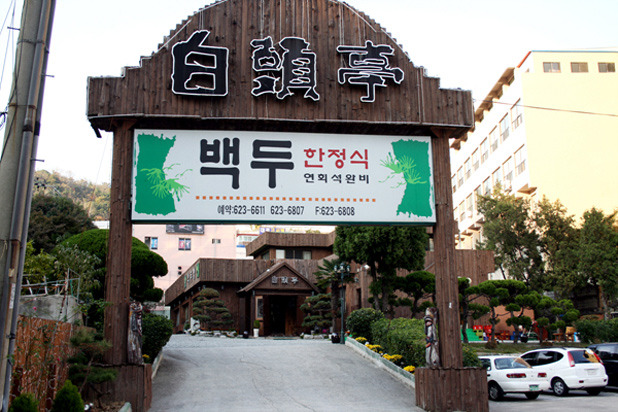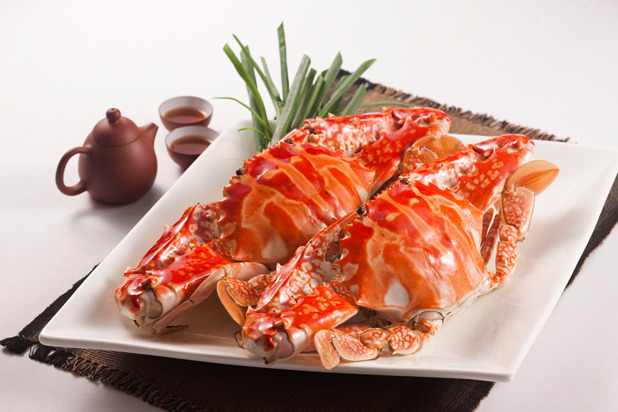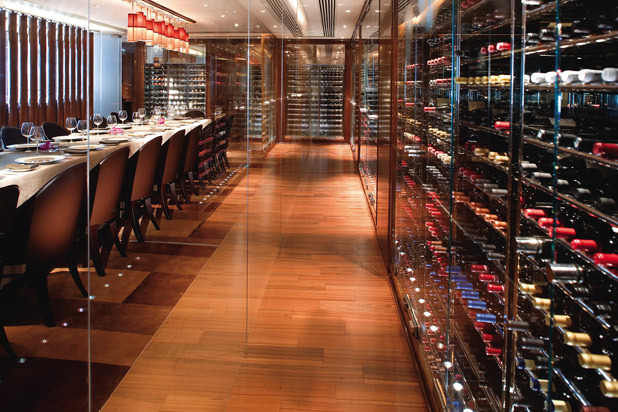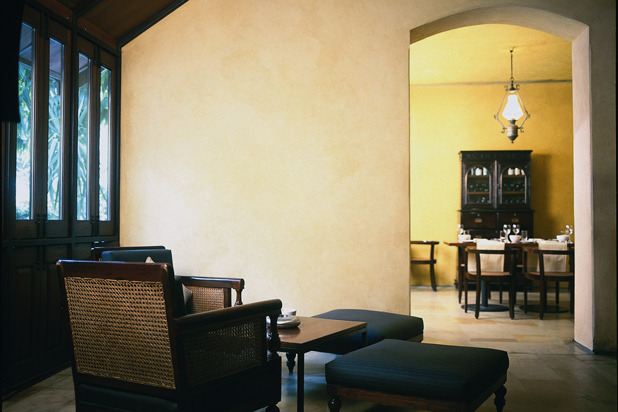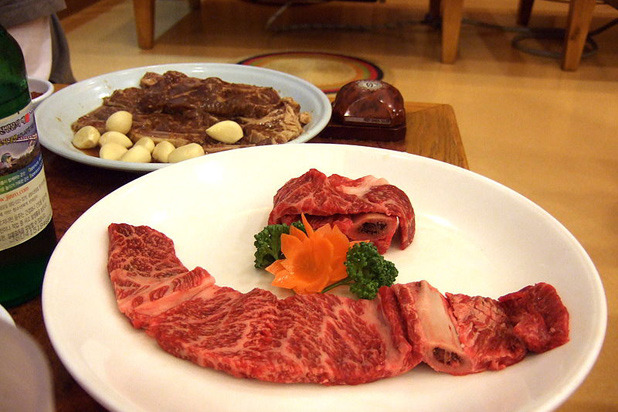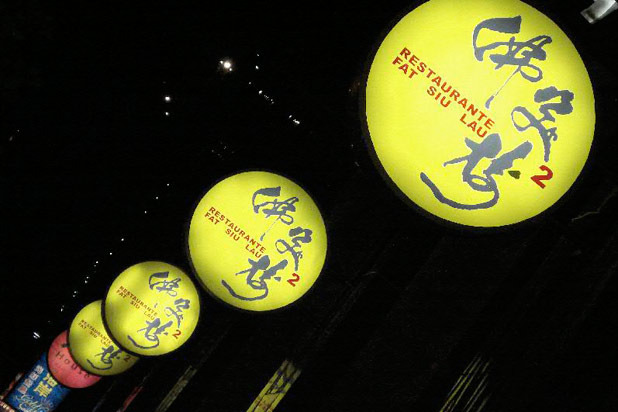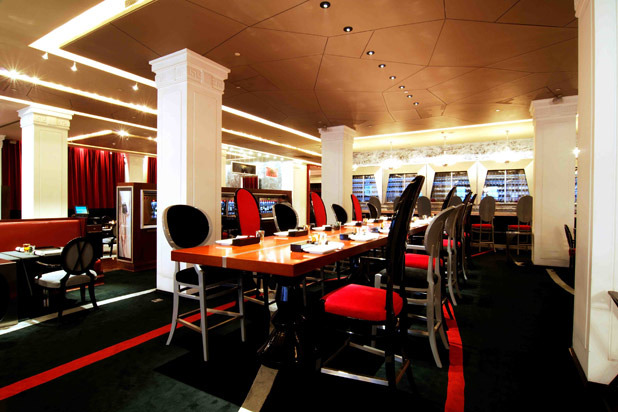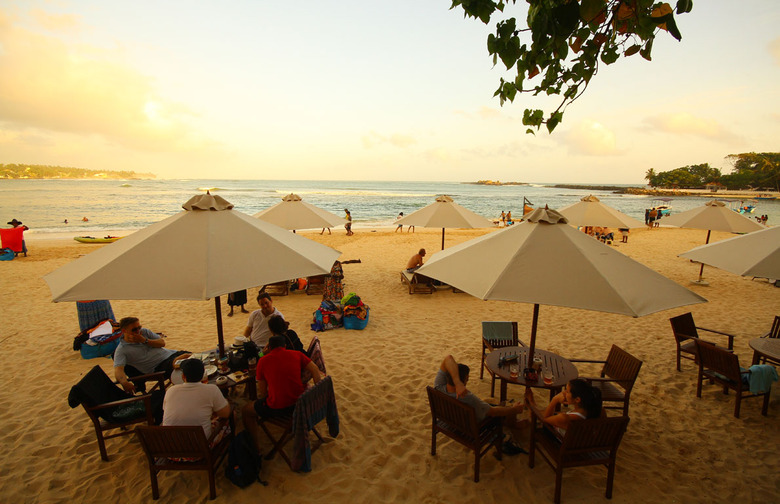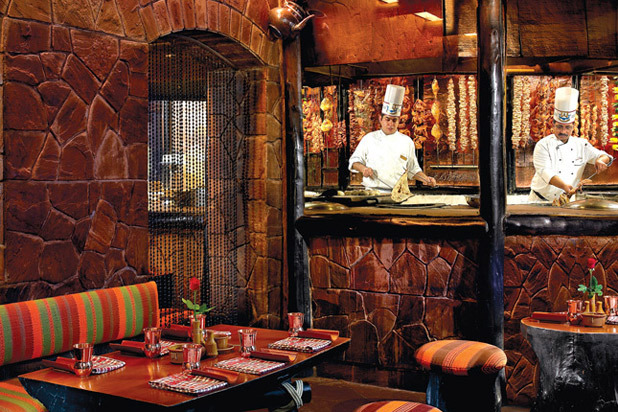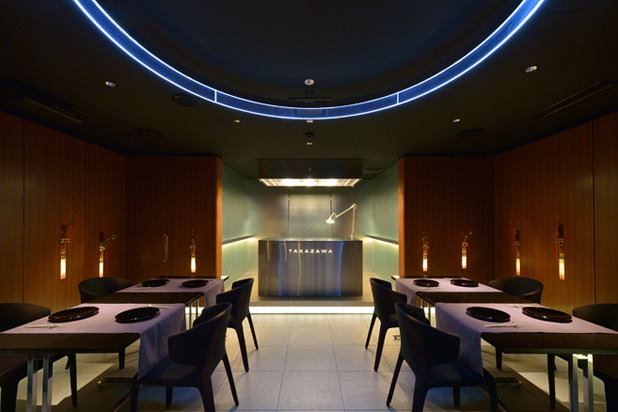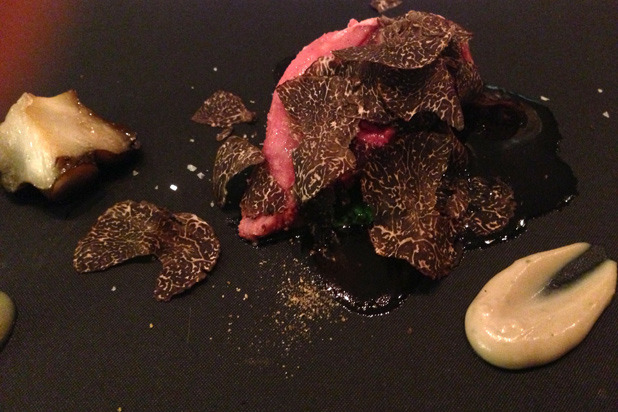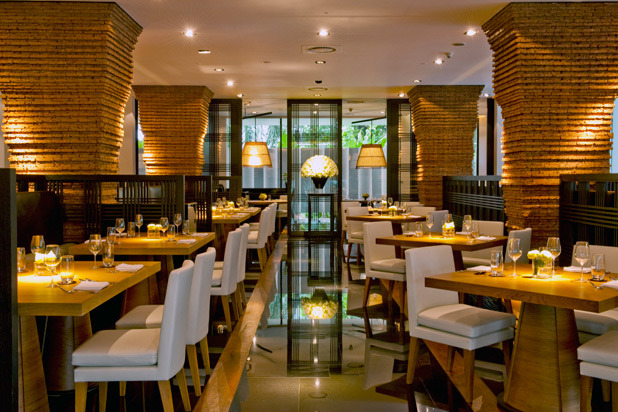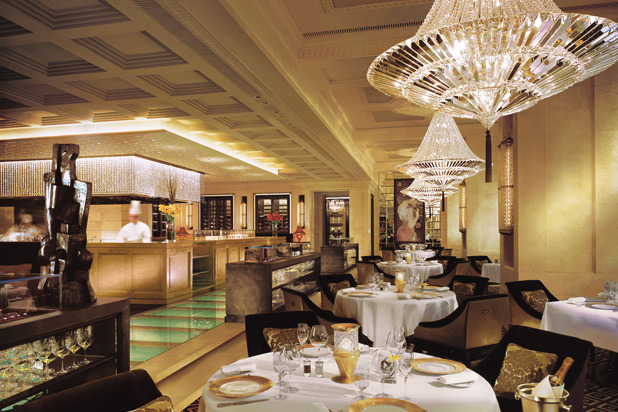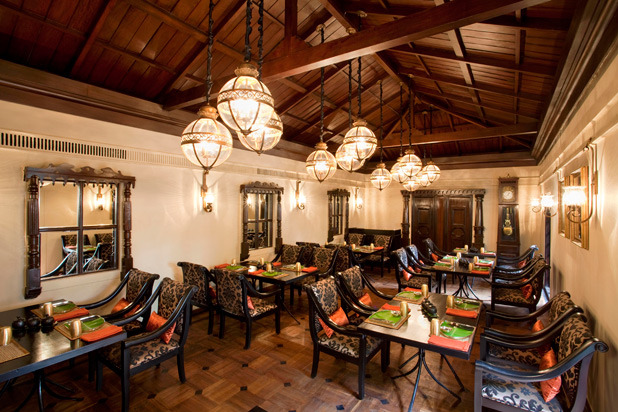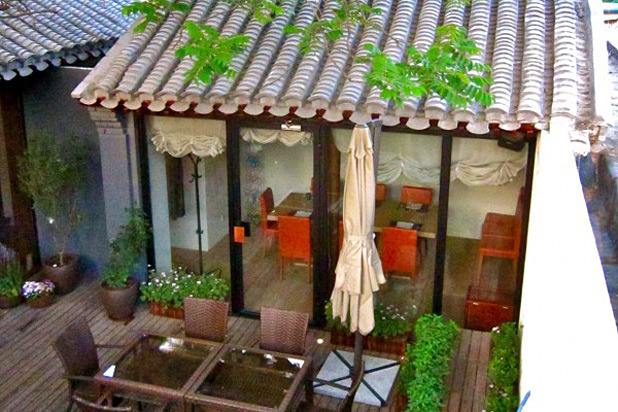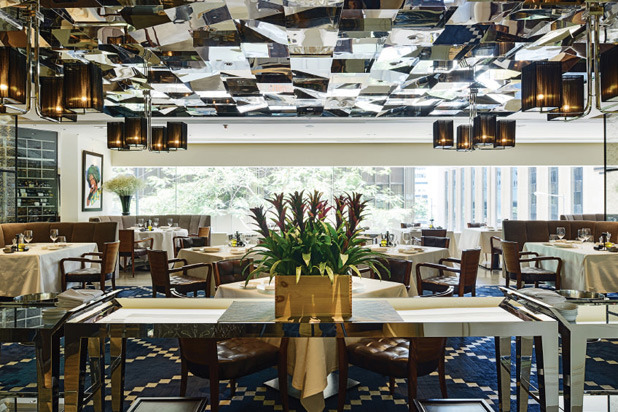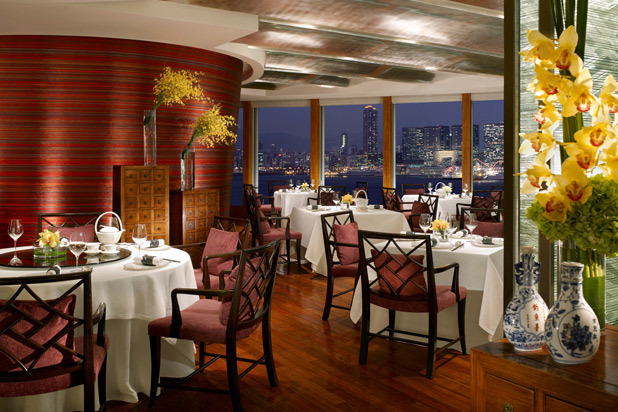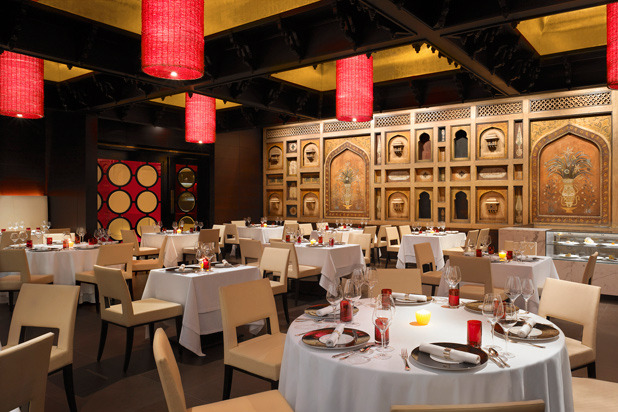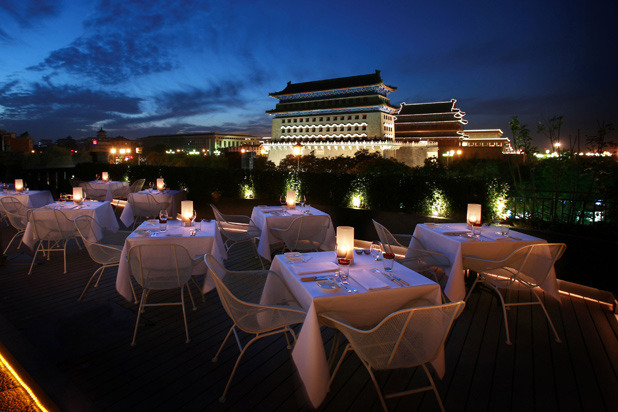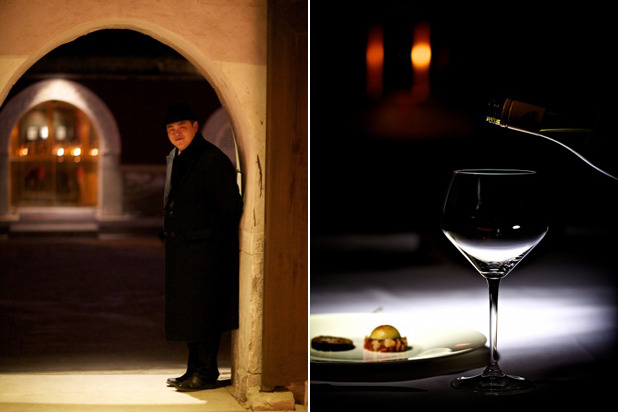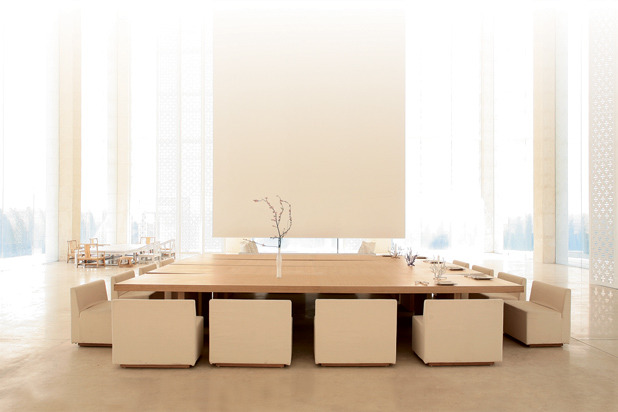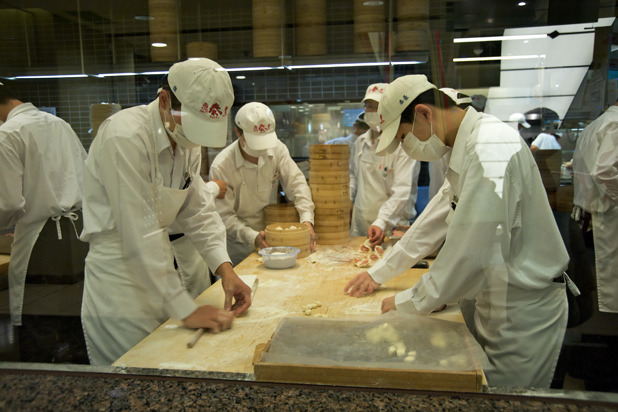101 Best Restaurants In Asia Slideshow
Why would anyone want to eat northern Thai food with Mediterranean accents in the history-rich resort community of Bintan, in Indonesia? Because that food is very, very good at this stand-alone restaurant on the grounds of the luxurious Nirwana Gardens Resort Hotel. Fried fish with green mango salad, coconut seafood soup, beef basil, and spring rolls filled with chicken, shrimp, and noodles are some of the offerings. Not just the herbs used in the cooking but the spices, too, are grown on the property. Add in excellent service, one of the best wine cellars in this part of the world, and heart-stopping views out over the South China Sea, and you've got a very special destination.
1 Indra Maya Estate, Nirwana Gardens, Bintan, Riau
100. Kitcho Arashiyama (Kyoto, Japan)
This 65-year-old classic, a Michelin three-star, with its lush garden setting and simply but handsomely furnished dining rooms, offers one of Kyoto's finest kaiseki experiences. Depending on the season and the availability of the best ingredients, the 10-course menu might include such delicacies as pickled tilefish with shiitake mushrooms and mountain potatoes; hamo eel in yuzu broth; ice fish with pickled vegetables, mustard leaves, and eggplant; Kyoto beef en gelée... Unusually for a restaurant of this type, there is a good wine list as well as the expected selection of quality sake.
58, Susukinobaba, SagaTenryuji, Ukyo
99. Karaiya Spice House (Beijing)
A low-key Hunanese restaurant in the lively Sanlitun district near the city center, run by mega-restaurateur Alan Wong, Karaiya — despite its name — tones down the fiery chile character of Hunan cuisine at least a little. Nonetheless, serious food lovers find their way here for the spicy marinated pork ribs, double-chile-flavor steamed fish, and immense flame-baked prawns, among other dishes.
S10-30 Sanlitun Village, 19 Sanlitun Lu, Chaoyang district
98. Jia 21 Hao (Beijing)
Gao Ming Jun, a popular Taiwanese pop singer, is the man behind this Chaoyang district hot spot, where Beijing's gilded youth comes to lounge around the interior palm trees for top-notch Guizhou, Guangxi, and Yunnan cuisine. Goat cheese (a Yunnan specialty) with fava beans, grilled perch with leeks, seafood soup with lemongrass and lime leaves, and a succulent steamed fish head that gets high marks from connoisseurs are among the dishes served.
21B Beitucheng Dong Lu Chaoyang district
97. Aqua (Hong Kong)
Situated on the top level of the city's 30-story One Peking Road building, Aqua is three venues in one: Aqua Tokyo (Japanese food), Aqua Roma (Italian food), and Aqua Spirit (a lively cocktail bar). Aqua Roma's menu highlights thin-crust pizzas, handmade pastas, and fresh seafood, while Aqua Tokyo takes Japanese cooking to "new heights" with specialties like baked black cod and Taraba crab with burdock and crab sauce.
1 Peking Rd
95. Mandarine (Ho Chi Minh City, Vietnam)
Mandarine, the sister property to Hoi An, which ranks 71 on our list, is an intimate, romantic, and upscale Chinese restaurant populated with Chinese screen paintings, wooden carvings, and live music. The menu is brimming with pricey spicy, sour, and salty dishes that are the hallmark of Chinese cuisine. While the menu includes delicacies like abalone, the foreign-friendly offerings also include the more approachable grilled bay scallops with chopped scallions, peanuts, and herbs, and beer-steamed crabs.
11A Ngo Van Nam Street, Dong Khoi Area
96. Bao Yuan Dumpling House (Beijing)
Bao Yuan has long had a good name among expats for quality dumplings at affordable prices. The modest interior, with photos of dishes, tiled walls, and paper lanterns, doesn't hint at the quality of the textured, juicy dumplings that diners order in plates of six. Kids and photographers alike can play around with mixing and matching colored dumplings, choosing wrappers dyed with carrots, tomatoes, purple cabbage, and spinach, while furtively glancing around to spot well-known diplomats grabbing lunch (including, in one instance, U.S. Treasury Secretary Jacob Lew).
6 Maizidian Jie, Chaoyang district
94. Sirocco (Bangkok, Thailand)
With its open-air dining room on the 63rd floor of The Dome at Lebua, Sirocco — named for the warm southeasterly Mediterranean wind — advertises itself as the world's highest alfresco restaurant. Its views of the Thai capital are certainly dazzling, while the excellent food seems to bring the Mediterranean to the table with such dishes as sweet pea bisque with seared king scallops, Parmesan, and bacon; sweet bell peppers confit with rosemary honey, anchovy cream, and tapenade, sea bass baked en croute with semi-dried tomatoes, Taggiasca olives, and pesto; lamb rack roasted in thyme ashes with wilted spinach and garlic purée; and yogurt panna cotta with cucumber granité.
The Dome at lebua 63rd floor, 1055/42 Silom Road, Bangrak
93. Long Beach Seafood Restaurant (Singapore)
The original branch of this seafood emporium opened its doors in 1946, serving both British soldiers and locals fresh seafood along the beach. The brand has since expanded to multiple locations, and the menu now includes crab and lobster varieties flown in from around the globe, but its original specialties, black pepper crab and chilli crab, are still favorites. Long Beach claims to have invented black pepper crab, in fact, along with another local seafood standard, drunken prawns with VSOP brandy — and is proud to boast Morgan Freeman and Lady Gaga as among its customers.
1018 East Coast Parkway
92. Three Guizhou Men (Beijing)
As its name might suggest, this place was opened by three friends from Guizhou Province, in southwestern China, to serve traditional dishes from their home region. This spicy, sour cuisine is a favorite of both tourists and locals, not to mention the post-clubbing crowd too lazy to battle hoards of people at other late-night places. Dishes range from sour fish soup to "Beef on fire," pieces of beef placed on chives over burning charcoal and seasoned with ground chiles.
39 E 3rd Ring Road Middle, Chaoyang
91. Friends the Restaurant (Phnom Penh, Cambodia)
This is one of five restaurants in Cambodia and Laos run by TREE Alliance, a worldwide enterprise dedicated to training young people in the hospitality business and related trades, in conjunction with Friends-International, which works with at-risk children and young people around Southeast Asia. You might not think that an establishment with a mission would make a list like this, but Friends the Restaurant is much more than a culinary charity. The friendly waitstaff — former street youth and their teachers — have been serving impeccable French and Khmer food in a bright and cheery dining room, its yellow walls crowded with art, for more than 10 years. Diners can enjoy options like roasted peppers, zucchini, and rocket salad spring rolls with basil lemon mayonnaise — and the frozen fruit-based shakes and daiquiris are legendary.
#215 Street 13
90. Hutong (Hong Kong)
On the 28th floor of a building devoted mostly to shops, Hutong — with its gorgeous waterfront views — isn't easy to find, but its modern takes on Chinese cuisine make it worth the search. Adventurous diners opt for deep-fried soft-shell crab, served on a bed of bright red deep-fried chiles, giving the dish its name: Red Lantern — not for the faint of heart, considering the sheer amount of chiles used. Diners can also try such upscale modern Chinese food as abalone carpaccio with spring onion oil, scallops tossed with pomelo segments, or thin-sliced pork belly with cucumber.
1 Peking Rd
28/F, One Peking Road, Tsim Sha Tsui
89. Man Fu Lou (Beijing)
This old-school hot pot establishment is one of Beijing's hidden gems, a casual hot spot for diners craving lamb and soup in the winter months. The imperial red-and-gold theme may come off as dated, but hand-cut Mongolian lamb, fatty beef, and other meats, served in individual copper pots are top quality, making this a destination especially popular with expats and out-of-towners.
38 Di'anmen Inner St, Xicheng
88. Petrus (Hong Kong)
Francophiles wandering around decidedly British Hong Kong might find refuge in the classically French feel of Petrus, decked out with opulent draperies, oil paintings, and crystal chandeliers. Chef Frederic Chabbert shows off his French training under Alain Ducasse at Le Louis XV in Monte Carlo, plating French pigeon alongside hazelnuts and muscat grapes, or enhancing organic eggs with black truffles. It helps that most of the produce is flown in from France, and the 1,900-bottle wine list (one of the most extensive lists in Asia) doesn't hurt, either.
Supreme Court Road, Level 56, Pacific Place, Central
87. My Humble House (Beijing)
Since 2004, the chefs at My Humble House have been pushing the boundaries of Chinese fusion cuisine. A stylish, artsy dining room built around a pool, My Humble House serves neo-classic Chinese dishes that aren't humble in presentation or price — such delights as oatmeal-crusted wasabi prawns; pan-fried foie gras with Chinese mushrooms and abalone jam; and wok-fried beef tenderloin with black pepper.
1 E Chang'an Ave, Dongcheng
86. Hiroshima (Taipei, Taiwan)
While simple appetizers like hamburger served on a sizzling skillet and fried chicken nuggets served with daikon and soy sauce are exquisite here, the half-dozen offerings of okonomiyaki are the restaurant's signature. This is a savory pancake, created in Hiroshima and cooked on a teppanyaki grill, stacked with layers of ingredients like cabbage, udon noodles, fried egg, corn, bacon, and cheese, all drizzled with a tangy brown sauce and sprinkled with fish flakes. Okonomiyaki, which has been called "the Japanese pizza" (though it's much more complex than everybody's favorite Mediterranean flatbread), is great washed down with a hot or cold sake.
No. 13, Lane 265, Sec 1, Tun Hwa South Road
85. Jing'An Restaurant (Shanghai)
Jing'An may have first made a splash with former executive chef Dane Clouston's foie gras and smoked chocolate pairing, but current executive chef Michael Wilson has made a name for the hotel restaurant with his fusion of Eastern and Western flavors. Situated on the second floor of the PuLi Hotel and Spa, the restaurant overlooks Jing'An Park and offers such dishes as black cod with black radish and shiitake mushrooms to showcase influences from Wilson's global travels.
1 Changde Rd
84. Santouka Ramen (Asahikawa, Japan)
The founder of Santouka Ramen — which today has outposts from Toronto to the Philippines — was inspired to open his first restaurant after watching the Japanese ramen-shop-based comedy Tampopo with his family. He took them for a quick post-movie ramen meal at a local noodle place, the story goes, and was so disappointed in the quality of what they ate that he vowed to make ramen of his own. After refining his recipe at family dinners, he opened his first tiny ramen shop in 1988, in Asahikawa on the island of Hokkaido. Santouka's simple signature shio (salt flavor) ramen is topped with Japanese pickled plum; another specialty is tokusen toroniku (pork) ramen, made with pork cheeks that, says the restaurant, are as tender as fatty tuna.
11-4 Nagayama, Asahikawa
83. Don Alfonso 1890 (Macau)
The original of this distinguished Italian restaurant, in Sant'Agata sui Due Golfi, on the Sorrentine Peninsula near Naples, has long been one of the standard-bearers for purely Mediterranean cooking of the highest order, based on the best Mediterranean ingredients. Can this formula translate to the onetime Portuguese enclave of Macau? Definitely. Ensconced in the Grand Lisboa hotel, Don Alfonso has brought its Old World Italian charm to a new range of customers. The atmosphere suggests traditional Italy, with old-fashioned wood décor, chandeliers, and white linen tablecloths, but the cooking is bright and up-to-date. Try the sweet paprika-smoked kingfish with zucchini "scapece style"; the octopus with couscous and provolone cheese foam scented with cinnamon; the potato gnocchi with artichoke, anchovies, black truffles, and pennyroyal mint; or the spring chicken "Cacciatora" with baby onions, cherry tomatoes, and olives.
3/F, Grand de Lisboa Macau, 2-4 Avenida De Lisboa, Praia Grande
82. The Chairman (Hong Kong)
It's tough to get a table at this much-talked-about restaurant in the backstreets of Hong Kong's Central District, but it's worth the trouble. A "retro-Chinese" establishment serving Cantonese food that's both traditional and reinvented, The Chairman sources raw materials with particular care (the pork comes from local farms; the beef from the U.S.). Go for the salted egg and bitter gourd salad with crispy shallots, the pan-fried whole crispy chicken stuffed with shrimp paste, and above all, the steamed fresh flower crab, "served with an aged Shaoxing wine, fragrant chicken oil, and flat rice noodles" — one of the most-buzzed-about dishes in Hong Kong.
No.18 Kau U Fong, Central
81. Brian McKenna @ The Courtyard (Beijing)
Brian McKenna @ The Courtyard is chef Brian McKenna's latest venture and revamp of the once-respected The Courtyard restaurant that for years was the European restaurant in Beijing. McKenna has revived the beleaguered and beloved restaurant adjacent to the Forbidden City with an intimate, stylish, nine-table dining room that overlooks the Forbidden City's moat. Many of the dishes are inspired from French, Italian, Spanish, and British dishes infused with Asian ingredients and flavors. The 12-course daily-changing tasting menu is the ideal way to sample McKenna's mastery. It may include rump and neck of Australian lamb with egg yolk, potato fondant, and basil cream; and poached trout salad with avocado and seafood salad and lemon yogurt.
No.95, Donghuamen Street
80. Hajime (Osaka, Japan)
It should be no surprise that three-Michelin-star Hajime landed on San Pellegrino's list of the 50 Best Restaurants in Asia (at an impressive number 21 spot). Chef Hajime Yoneda bases his contemporary French-inspired cuisine, according to their website, on "the balance and harmony of nature, the Earth, and space." A dish called "minéreal," for instance, is made up of 105 different vegetables and herbs, and sakaramasu, an uncommon fish called masu salmon or cherry salmon in English, is cloaked in puréed lemon vinaigrette and garnished with kumquat and fennel. Later on in the tasting menu, parsnip soup with truffle ice cream offers a surprising contrast of flavors and temperatures, and for dessert, croissant-flavored ice cream with a cacao mousse is simply stunning.
1-9-11-1F, Edobori, Nishi-Ku, Osaka-City
67. Transit (Beijing)
Sichuan-born chef Huang Chao opened Transit in 2002, but it burned down in 2006, just as it was hitting its stride. Loyal followers of the chef's unique brand of modern Sichuan cooking kept their fingers crossed, and in 2011, Transit reopened, picking up right where it left off, and is now regarded as one of Beijing's best in the Sichuan style — a serious game-changer in the city's international dining scene — perfecting the old standards but not afraid to give them a unique twist. Dan dan mian, a wheat noodle dish with a porky, spicy broth, is livened up by a wedge of Meyer lemon. A giant, chile-coated prawn is served in its shell alongside asparagus and chocolate sauce. Spicy, sticky pork spareribs are coated in seasoned sticky rice. Your mouth might be on fire after a meal at Transit, but it's not a meal you're likely to forget any time soon.
N4-36, Third Floor, The Village North, Sanlitun Lu, Chaoyang District
79. Garuda Padang Cuisine (Jakarta, Indonesia)
What to expect from this outlet of the Garuda Padang Cuisine chain? A clean, comfortable atmosphere that offers the best of Padang cooking to neophytes and regulars alike. Padang, the capital of West Sumatra, is famous for its cooking, specifically the dishes of the indigenous Minangkabau people. Some dishes to try: green curry green beans, oysters in spicy red pepper sauce, shrimp curry, and above all, beef rendang, the spicy stew that is the most famous of all Minangkabau dishes.
Jln. Hayam Wuruk No. 100
78. Camões (Macau)
Head to Camões in Fisherman's Wharf for authentic Portuguese cuisine served alfresco on the restaurant's vast balcony. The restaurant is named after the 16th-century Portuguese poet Luís Vaz de Camões, and the menu offers exemplary Portuguese cuisine along the water in the former Portuguese enclave. An ideal sampling of the restaurant's offerings include couvert of green bean fritters, fried shrimp, codfish cakes, beef croquettes, fresh milk cheese, and octopus and pigeon salads; seafood soup served in a fresh bread bowl; and charcoal-grilled beef and pork rib churrasco. Regularly scheduled live music adds to the ambiance transforming diners to Portugal.
Lisboa 3, 1/F, Macau Fisherman's Wharf, Av. da Amizade, Alameda Dutor Carlos d'Assumpção
77. Sushi Mizutani (Tokyo)
Ten seats, three Michelin stars, two to three months to get a reservation (and nobody speaks English on the phone) — and definitely worth a visit. Master sushi chef Hachiro Mizutani, who studied under sushi legend Jiro Ono, is a perfectionist, especially famous for his nigiri (the steamed abalone version is a must) and for his subtle use of vinegar, and his rice is said to be some of the best in Tokyo. He works alone, preparing everything himself. The atmosphere here is relaxed but sophisticated, but two caveats must be issued: Though it is located in the popular Ginza district, it is hidden away on the ninth floor of an elevator building, with signage only in Japanese; and it is cash-only — and lots of cash, at that.
Juno Building 9/F, 8-7-7 Ginza, Chuo-ku
76. La Cocotte (Taipei, Taiwan)
Named for the cast-iron pot popular in traditional French cookery, La Cocotte is a French-inspired restaurant under the direction of chef Fabien Vergé, who cooked at the Hôtel Le Meurice and other acclaimed restaurants before moving to Taipei. The restaurant's ambiance is cozy, and less formal than most French outposts in Asia, and offers a menu inspired by signature dishes that were handed down by Vergé's grandmother, including a classic seared cod with sautéed asparagus.
No. 20, Lane 13, Section 2, Jnshn South Rd, Daan District
75. Restaurant Guy Savoy (Singapore)
This thriving capital's over-the-top Marina Bay Sands complex — three Moshe Safdie-designed towers housing a casino, a 2,561-room hotel, an immense convention center, 800,000 square feet of shops, an ice-skating rink, a rooftop pool, a museum, and who knows what else — went for the big names when installing its restaurants: Wolfgang Puck, Mario Batali, Daniel Boulud, Tetsuya Wakuda, and Guy Savoy all have outposts here (so did the great Catalan chef Santi Santamaria, but his place closed after his untimely demise). Savoy is one of the most consistent and consistently pleasing of France's three-star chefs, and he has sent some of the best kitchen and dining room personnel from his Paris flagship to ensure that his classic preparations are perfectly executed and presented here. Oysters en gelée, artichoke and black truffle soup, crispy sea bass with delicate spices, grapefruit terrine with tea sauce, and other Savoy signature dishes taste every bit as good here as they do back home.
10 Bayfront Avenue, #L2-01 Casino Level 2 Marina Bay Sands
74. Seventy-Two Beef Noodle Restaurant (Taipei, Taiwan)
No frills, amazing noodles. This small, inexpensive restaurant winds up on every list of the best noodle shops in Taipei (and therefore the world), and with good reason. Order the white broth noodle soup, made with ox bones that have been steeped for 72 hours, and the resultant opaque broth, enhanced with a dash of chile sauce and sea salt, and you'll never look at a bowl of soup the same way again. Their stinky tofu, in a rich, meaty sauce, is also some of the best you'll find, anywhere.
No.188, Sec.1, Jian-Guo South Road, Da-An District
73. Iggy's (Singapore)
The name might sound unassuming, but Iggy's, with a kitchen twice the size of the dining room, is one of the world's most exclusive dining experiences (and — oh yeah — it was named the best restaurant in all of Asia four years in a row by the Miele Guide). There are only a handful of tables, a dessert bar, and an intimate lounge, and the highest-end ingredients available go into each playful dish, drawing influence from all over the world and pushing the boundaries of not only the sensory experience of food, but also service. Chef/owner Ignatius Chan takes guests far out of their comfort zone in the style of Heston Blumenthal or Ferran Adrià, and each dish cranks all of your senses up to 11. "Fresh oysters set in a sake aspic with flecks of flowers" is served on a blue glass plate; "a salad of 34 different leaves and petals" is so artfully composed that you won't want to disturb it (especially after the server names all 34 of them); you'll be remembering the sea urchin with cauliflower, abalone, and shiso for years afterward. And don't forget to spend some time perusing the wine list; Iggy hand-selects each burgundy (in many cases visiting the growers yearly), and it's considered one of the world's best.
581 Orchard Rd
72. Hatsune (Beijing)
For years, Hatsune has been the go-to place for California-style rolls and sushi in Beijing. While the basic premise of the menu is familiar to fans of American-style sushi rolls, it has elevated the status of its proprietor Alan Wong, who has gone onto open a handful of Japanese restaurants in Beijing and Shanghai. While the minimalistic Guanghua Lu outpost is the original location for Wong's neo-Classic Japanese fare, the outpost in Sanlitun Village South is a livelier option. Grab a seat at the bar adorned with taiko drums and sip sake while tucking into rolls like the Motorola (raw and cooked tuna, crabmeat, avocado, and roe) and Butterfly roll (eel, crab roe, avocado and shrimp).
2/F, Heqiao Bldg C, 8A Guanghua Lu, Chaoyang District
71. Hoi An (Ho Chi Minh City, Vietnam)
Hoi An (its sister restaurant is Mandarine; see number 95) offers a quintessential Vietnamese dining experience. Named for a central Vietnamese coast town influenced by Chinese and French settlers, the romantic, cozy French-Vietnamese dining room is a fitting setting for a menu of grilled shrimp in banana leaf with lime juice and salt; tiny rice custards with crumbled shrimp; fried chicken with lemon sauce; and cao lau — thin slices of pork, shrimp, and sesame cake served on rice noodles — accompanied with marrow-bone broth.
11 Le Thanh Ton Street Districe 1, Dong Khoi Area
70. Osteria de Angie (Taipei, Taiwan)
Taipei might not be the first place you'd expect to find one of the world's best Italian restaurants, but that's exactly what Sicilian-born chef/ owner Giorgio Pappalardo had in mind when he opened Osteria de Angie after stints with several Michelin-starred chefs, including France's Alain Ducasse. Communal dining is the focus in the sleek, simple dining room, and while the menu has plenty of traditional Italian specialties, including beef carpaccio, mushroom risotto, and assorted antipasto, it also includes a 35-ounce rib-eye, oven-roasted Boston lobster, pizzas, and handmade pastas such as spaghetti al tartufo, tossed with seasonal vegetables and plenty of black truffle.
No. 33, Lane 280, Guangfu South Road, Da-An Dist
69. Nihonryori RyuGin (Tokyo)
Under the auspices of chef Seiji Yamamoto, Tokyo's RyuGin was awarded three Michelin stars for 2013. While the dragon-themed dining room might be a bit sparse, the food and service are anything but. The cuisine is a play on traditional Kyoto fare, celebrating the freshest seasonal ingredients. The à la carte menu boasts 50 dishes, and the 10-course Spring Gastronomy Menu includes an "array of spring vegetables with one sip of clam clear soup" and other dishes of varying temperatures, including an intriguing-sounding "'Flavored Dish' to feel the Grace of Japan." The staff is incredibly knowledgeable and can walk you through the nuances of the entire meal, and the kitchen is accommodating to preferences and allergies.
7-17-24 Roppongi, Minato
68. Felix (Hong Kong)
A meal at this luxurious restaurant, located on the 28th floor of Hong Kong's swanky Peninsula Hotel, comes with great visuals, both inside and out. Designed by the renowned Philippe Starck, the space is avant-garde, ultra-contemporary, and a bit surreal (seatbacks are imprinted with photos of the hotel's longtime employees). The floor-to-ceiling windows, meanwhile, offer one of the best views of the city that you're likely to find. Instead of a menu, diners are handed iPads with photos of each "Modern European" dish. Chef Yoshiharu Kaji's Signature Menu changes regularly, but on any given day can include items like Grand Marnier-marinated pan-fried foie gras with caramelized strawberries, fennel consommé with yogurt-lemon verbena mousse, shrimp dumpling with fennel-orange purée, and Parmesan crème brûlée.
Salisbury Road, Tsim Sha Tsui
66. Bo.lan (Bangkok, Thailand)
Upscale Thai cooking in Bangkok tends to be hit or miss, as it's oftentimes dumbed down for tourists. But even though Bo.lan — both a play on the owners' names, Bo and Dylan, as well as the Thai word for "ancient" — is packed every night with well-heeled tourists, the cuisine isn't compromised in the least.
The couple, who formerly worked at the now-closed London branch of chef David Thompson's acclaimed Nahm (see number 19 for Nahm in Bangkok), turned a former house into an oasis of dark wood, woven baskets, fountains, and greenery, and serve truly authentic fare, taking advantage of the freshest seasonal ingredients and rare herbs. The Bo.lan Balance, a tasting menu that changes every two months, is full of surprises intended to take you out of your comfort zone, including the Mhoo Iham, a red curry and minced pork cooked in bamboo.
42 Sukhumvit 26 Soi Pichai Ronnarong Songkram Klongtoey
65. Sawada (Tokyo)
Sawada is a six-seat, husband-and-wife run Ginza sushi restaurant that offers an impeccable omakase menu and an intimate dining experience. At this Michelin two-star establishment, chef Koji Sawada prepares a three-hour-long feast that offers some of the finest seasonal wild seafood from all over Japan, some of it cured or lightly torched. David Chang has called this his favorite sushi bar in the world, and it's easy to see why.
461 Negishi, Iruma, Saitama Prefecture 358-0034
64. Mozaic (Bali, Indonesia)
This elegant restaurant, in a beautiful tropical setting with a lantern-lit outdoor patio, offers four six-course tasting menus, each offering a unique culinary experience. The chef's tasting menu , for instance, offers a French-influenced array of dishes that might include foie gras with mango three ways, slow-roasted pigeon with beets and cèpes, and Valrhona hazelnut chocolate mousse, among other courses; the discovery menu stays closer to home with Indonesian-inspired dishes along the lines of grilled tiger prawns with ginger flower-infused pink grapefruit; Javanese quail and foie gras pastilla with Balinese rujak sauce and apple-saffron marmalade; and calamansi lime sorbet with black rice and lemon pepper tuile. A vegetarian menu and a "chef's surprise" (including "the finest, rarest and most precious ingredients in season including fresh winter black truffles and caviar") round out the possibilities.
Jl. Raya Sanggingan, Ubud
63. Nicholini’s (Hong Kong)
Experience the cuisine of northern Italy — with views of Hong Kong from the heart of the city — at Nicholini's, located in the Conrad Hotel. Voted Hong Kong's Best Restaurant by Hong Kong Tatler for the past 19 years, this Italian retreat is known for its house-made pastas (including agnolotti filled with black truffles and mascarpone), as well as such other specialties as porcini strudel with Taleggio sauce, pistachio-crusted baby rack of lamb, and line-caught sea bass with onions, olives, and capers.
88 Queensway
62. Ishikawa (Tokyo)
A sanctuary of tranquility within Tokyo's bustling streets, Ishikawa features unique Japanese cuisine from renowned chef Hideki Ishikawa. Despite winning three stars from Michelin, the chef is known for his modesty and his diner-comes-first approach to service. Located in the so-called geisha district of Tokyo, the restaurant operates under the centuries-old concept of omotenashi, which means meeting a diner's expectations and anticipating any unforeseen ones. While you'll enjoy a daily menu of chef's selections in the sleek, teak wood space, past diners have experienced elegant dishes such as grilled eel with sweet onion and beef tongue with turnip and mountain vegetables.
5-37 Kagurazaka, Shinjuku
61. Goga (Shanghai)
While the name of this Shanghai eatery may seem out of place — Goga is shorthand for the Golden Gate Bridge — as soon as you meet its Hawaiian print shirt-clad chef and owner Brad Turley, you'll understand the California reference. After a few stints in the States and more than a decade of experience cooking in Asia, Turley opened this quirky spot that features light American-Californian fare with subtle touches of Japanese and Thai cuisine. You'll find Turley at his restaurant almost every single night, serving dishes like miso cod, torched tuna, and steaks. The small and intimate space is known for its casual vibe and great patio.
1 Yueyang Rd, Xuhui
60. Quintessence (Tokyo)
Quintessence is a Michelin three-star restaurant under the direction of chef Shuzo Kishida, who refined his skills at L'Astrance in Paris. His dedication to serving the freshest seasonal ingredients led him to offer only one fixed-price carte blanche (chef's choice) menu daily — seven courses at lunchtime, 13 at dinner. Examples of his fare include smoked salmon "without the smoke," wild mushroom sablé, three-hour roasted shonai-sangen pork with potatoes, mushrooms, and broccoli.
1F Barbizon 25 building, 5-4-7 Shirokanedai, Minato-Ku
59. Ultraviolet by Paul Pairet (Shanghai)
French chef Paul Pairet offers a globe-trotting, highly experimental 20-course set menu with sides of multi-sensorial technologies. The very location of the restaurant has been kept secret; diners who make advanced reservations (only 10 people are allowed each night and the waiting list is often three months long or more) are given a meeting spot where they are picked up by restaurant staff and seated at a single table situated in a dining room devoid of décor. Instead, the Spartan white-walled chamber is tricked out with LED floor strips, pin projectors, infrared cameras, and dry scent diffusors; each course comes accompanied by complementary lights, sounds, music, scents, and visual effects. Dishes begin in bite-sized portions and get progressively bigger, like a culinary crescendo, before shifting to digestives and sweets of diminishing sizes.
c/o Bund 18, 6/F, 18 Zhongshan Dong Yi Road
58. La Maison 1888 (Danang, Vietnam)
Here you'll dine in an exquisite French setting inside Vietnam's Intercontinental Danang Sun Peninsula Resort. Under the helm of U.K.-based Michelin three-star chef Michel Roux, La Maison 1888 offers haute French cuisine with subtle Asian flavors. Expect to enjoy dishes like fillet of steamed bass wrapped in a seaweed crust and pan-fried scallops served with a lime-scented carrot purée. Designed after an antique French mansion, the restaurant's beautiful interior is worth the trip in itself. If the setting and your delicious meal haven't captivated you yet, be ready to swoon during your post-dinner drinks out on the veranda of the restaurant's Buffalo Bar, where you'll enjoy unique cocktails from their menu of aged whiskies and infused vodkas.
Bai Bac, Son Tra Peninsula
57. The Drawing Room (Hong Kong)
Locals and expats alike can share stories about a time when Italian dining in Hong Kong meant spaghetti pomodoro made with ketchup or pizza from the Hut. But those days are thankfully a thing of the past. Now, inside the sleek Philippe Starck-designed J Plus Hotel at The Drawing Room in Causeway Bay, at a restaurant launched during the worldwide economic downturn in a seemingly cursed spot by three investment bankers with little to no food-and-beverage knowledge, you can sit down to a four- or five-course modern Italian tasting menu that's one of the hottest reservations in town. Much of its success can be attributed to the fact that the owners had the good sense to land a chef with great pedigree: local celebrity chef Roland Schuller. Seafood is a specialty at this contemporary Italian place, and the menu changes, of course, but signature dishes include pan-fried quail and foie gras, a trio of Wagyu short rib, beef tenderloin, and ox tongue, and the linguine with Canary Island red prawns and crispy artichokes. Guaranteed there's no Heinz there.
Jia Boutique Hotel 1 Irving St, Causeway Bay
56. Liqun Roast Duck (Beijing)
In a hutong (alleyway) northeast of the ancient Qianmen gate is the humble home of some of Beijing's best Peking duck. The tiny family-run restaurant serves duck in many forms, including the bird's gizzard and intestines, but the signature dish of the Chinese capital is the signature dish here. The slow-roasted duck is served with scallions, cucumbers, and hoisin sauce, to be wrapped in steamed pancake by each diner. To make sure you get this classic dish, order it when you reserve your table.
11 Beixiangfeng Hutong, Dongcheng
55. Orient Express (New Delhi, India)
Honored in The Daily Meal's inaugural 101 Best Hotel Restaurants Around the World, Orient Express at the Taj Palace hotel pays homage to the opulent train travel its namesake afforded passengers during the Belle Époque. The dining room is modeled after the dining car on that legendary train, and the bar replicates a railway station platform. The kitchen, led by D.N. Sharma, executive chef since the restaurant opened in 1983, and David Tilly, is European, offering such dishes as escalope of duck foie gras; Normandy Camembert cheese soufflé; Canadian scallops; French duck breast; and rosemary soufflé.
70 Janpath Road
54. Farmer’s Original Handmade Hamburger (Busan, South Korea)
Those who dispute whether a burger joint belongs on a best restaurant list should refer to The Daily Meal's 101 Best Restaurants in America for 2013, where Danny Meyer's New York original, Shake Shack, cracked the country's top 20 spots for life-changing meals. "But Korea?" some are asking. Considering the longtime American presence in South Korea, this should be no surprise. Farmer's Original Handmade Hamburger delivers the goods with a menu of eight burgers named for (and supposed to be representative of) American states and cities around the world. A Honolulu burger understandably comes with pineapple, and a Texas burger is layered with barbecue sauce; a New York burger is slathered in... cream cheese sauce? But even where license may be taken with authenticity, there's no lack of great flavor. Anyone looking to satisfy a craving for great burgers and fries can stop in here for some of Asia's best.
25 Changseondong, Jung-gu
53. Cépage (Hong Kong)
At this sleek contemporary-style three-level restaurant, chef Sebastien Lepinoy, a protégé of Joël Robuchon, offers a French-Mediterranean menu with Asian accents. The menu offers such fare as lightly smoked eel with Dijon mustard and dashi bouillon, miso-marinated black cod with young ginger and miso sauce, and baked pheasant pie with foie gras.
23 Wing Fung St, Wan Chai
52. Sushi Oyama (Shanghai)
Located on the top floor of a French Concession house, this intimate escape features fresh fish selections flown in directly from Japan on an omakase menu. The restaurant is known for exceptional service that is both perfectly accommodating and knowledgeable, and with only 14 seats in the house, it's best to try to get a reservation here well in advance. Some say that Sushi Oyama serves the finest sushi in all of Shanghai, a city increasingly known for this Japanese specialty.
20 Donghu Rd, Xuhui
51. Yat Lok Restaurant (Hong Kong)
Come to this restaurant for Chinese barbecue, and you won't be disappointed. The stars of the menu are very tender char siu (barbecued pork) and roast goose, unforgettable for its juicy meat, its crisp skin, and the layer of delicious fat that separate the two. Located in the neighborhood of Tai Po, Yat Lok is about 40 minutes by mass transit from the central business district, but it's well worth the trek. Ambience? Who cares when the food is this good?
G/F, 34-38 Stanley Street
50. Nonzero (Taipei, Taiwan)
When Nonzero first opened in Taipei in 2008, restaurants sourcing organic ingredients and serving them at communal tables was a new concept in Taipei. The décor at this bright and airy café, minimalist but homey, suggests that of a sustainably built house: the herringbone marble floor was laid using stone-quarry scraps, the walls were reclaimed from a farmhouse, and the façade is covered in tiles made of tree-fern wood. A large communal table is the centerpiece of the dining room, with an open kitchen to the side whipping up simple, seasonal, healthy, organic dishes like slow-cooked red wine beef cheeks with cucumber corn salad and roast spring chicken with apple, reflecting the rich international life experiences of owner Chu Ping, who has lived in the U.S., Malaysia, Australia, and New Zealand.
No.5, Alley 4, Lane 27, Ren-Ai Road, Sec. 4
49. Noodle Loft (Beijing)
Grab a seat at Noodle Loft's bar to catch a glimpse of the knife-wielding noodle masters who expertly slice, dice, and hand-pull noodles of all shapes and sizes at lightning speed before tossing them into pots of boiling water. The chewy Shanxi noodles are shaken into bowls and diners top them with savory broths and toppings like scrambled eggs stewed with tomatoes, mushrooms, vinegar, hot oil, cilantro, and bean sprouts at the soup bar.
3 Guangshun N St, Chaoyang
48. Kojyu (Tokyo)
This hidden gem, specializing in the Kyoto-born kaiseki experience, is a favorite among diners looking for a special-occasion experience. Diners can opt to sit at the warm and inviting counter, which has a minimalist approach and soft lighting that fosters calm, or in private dining rooms that offer either tatami-style or normal seating. The particulars of the meal change constantly, but expect such fare as Hokkaido uni with horse crab and eggplant, dashi soup with shrimp ball and matsutake mushrooms, octopus with pumpkin and winter melon, and excellent sashimi.
Carioca building, 4F Kojyu, BF Okuda
47. Ojangdong Hamheung Naengmyeon (Seoul, South Korea)
A place that names itself after its signature dish — hamheung naengmyeon, a preparation of cold noodles in broth — sets expectations high, and any deviation from excellence is just unacceptable to lovers of that specialty. Especially popular in Korea as summertime fare, naengmyeon is served either with a cold broth made from beef, chicken, or radish kimchi, or with a dressing of gochujang, Korean red chile paste. Here, the specialty is the kind made with gochujang dressing, with marinated stingray as the featured protein and pleasantly chewy noodles that set Ojangdong Hamheung Naengmyeon apart from other establishments.
108, Mareunnae-ro, Jung-gu
46. CUT (Singapore)
Singapore is a mecca for the food-obsessed, so it was a logical choice when Wolfgang Puck was scouting for a third location for his award-winning steakhouse, CUT. The same level of quality and attention to detail carries over from the original location in Beverly Hills (the second one is in London), reflected in the execution of the menu and the ultra-chic décor by famed designer Tony Chi. Notable items include Wagyu beef from Japan in three popular cuts — sirloin, rib-eye, and filet mignon — and a starter of bone marrow flan with mushroom marmalade and parsley salad. All steaks are started over a wood or charcoal grill, then finished under a 1,200-degree broiler.
10 Bayfront Avenue
45. Yung Kee (Hong Kong)
You cannot leave Hong Kong without making a visit to Yung Kee for its house special: the roast goose. The restaurant has been around for more than 70 years, starting (as these things are apt to do) as a more informal affair near the old Hong Kong-Macau ferry pier. Its founder, Kam Shui Fai, started out in 1938, converting the place into a more formal restaurant in 1942. It was destroyed by Japanese air raids during World War II and moved twice since, in 1944 and 1964. Success seemed to follow. It's been on best-of lists going back to 1968 when Fortune singled it out as one of the world's 15 best restaurants, and today it reportedly nets more than $50 million a year in profit. Go, lay out the $150 for the Deluxe Dinner for Two: preserved eggs and pickled ginger, roasted goose with preserved trotter and soy sauce, deep-fried prawn with mini-crab roe, abalone with mushroom in "superior soup," steamed garoupa with Chinese ham, wonton noodles, and mango pudding — and check this seemingly gold-plated institution in Hong Kong's Central district off your list.
32 Wellington St, Hong Kong Island
44. Alameda (Beijing)
Alameda is a great place to go when you're looking for something a little different in Beijing. On a clear day, light pours in through the glass walls and ceilings. Although it's billed as Brazilian, the menu wanders a bit off the beaten path and perhaps is more accurately described as Mediterranean with American West Coast influences. Once the food arrives, however, diners won't really care what category it fits into. Don't miss the pan-fried snapper with salsa verde and the risotto of the day.
Nali Mall Sanlitun Beijie (bet. Sanlitun Xiliujie & Sanlitun Xiwujie)
43. Tu Hsiao Yueh (Taipei, Taiwan)
In 1895, Hong Yu-lou, a Taiwanese fisherman who found it hard to make a living during slack season when the seas were too rough to fish, began to supplement his income by handcrafting tasty noodles, which he sold from a pouch suspended from two long poles balanced on his shoulders. His noodles soon became the talk of his home of Tainan. More than 100 years later, a noodle master still sits on a small stool at the entryway of each restaurant expertly preparing the same famous danzai noodles Hong did, served dry or in soup topped with bean sprouts, minced pork, shallots, bok choy, and one boiled shrimp.
No. 12, Alley 8, Lane 216, Zhongxiao East Road, Section 4, Da-an District
42. Sushi Saito (Tokyo)
Located in Akasaka, across the street from the U.S. embassy, Sushi Saito is widely regarded as one of Tokyo's top sushi restaurants. While the spotlight may currently be on Sukiyabashi Jiro (see number 15) for many visitors to Japan, it's important to remember that there are many other fish in the sea. Master sushi chef Takashi Saito has worked hard to earn his three Michelin stars, and the fact that his establishment has only seven seats and is located in a parking garage hasn't deterred diners from seeking out a meal here — a relative steal, considering the quality. If available, try the three tunas: lean akami, medium-fatty chu-toro, and the much-prized o-toro, which has the most marbling.
Jidousha Kaikan Bldg. F1, 1-9-15 Akasaka, Minato-ku
41. Man Wah (Hong Kong)
The panoramic view of Victoria Harbor and the Hong Kong cityscape from the 25th-floor dining room of Man Wah, in the Mandarin Oriental Hotel, is as impressive today as it was when the restaurant and hotel first opened in 1963. Equally impressive is this Cantonese restaurant's cuisine, by executive chef Man-Sing Lee. (We singled out the place in The Daily Meal's inaugural 101 Best Hotel Restaurants Around the World). Local rosewood, lacquered enamel, gold-plated birdcage ceiling lamps, and original silk paintings by artist David Wong fill the dining room. In addition to delicate dim sum, Man Wah's signature dishes include steamed spotted garoupa fillet with crispy ginger, crabmeat with egg white sauce, and wok-fried sole with black bean sauce.
5 Connaught Rd, Central
40. Southern Barbarian (Beijing)
Southern Barbarian is a hot spot for Yunnan cuisine. The owner, Feng Jianwen, is passionate about bringing the flavors of his home province to life, with dishes like "Crossing the Bridge" Noodles, spicy garlic chicken wings, and potato pancakes. Diners feel welcome in the warm and inviting interior, which showcases photography from some of China's best photographers and videographers.
107 Baochao Hutong, Dongcheng district
39. L'Atelier de Joël Robuchon (Hong Kong)
Though legendary French chef Joël Robuchon credits a tapas bar in Alicante, Spain, for inspiring his counter-service L'Atelier format, the first example of this now international chain opened in Tokyo in 2003, a few months before his first Parisian "atelier" (studio) was launched — and the resemblance of the place to a sushi bar cannot be ignored. He now has L'Ateliers around the world. They're all good, but this Hong Kong hot spot is the only one with three Michelin stars. The format is basically modern (and sometimes classic) French cuisine served tapas-style, from white asparagus velouté with paprika and hollandaise cream to roast guinea fowl with herbs, mushrooms, and crushed potatoes to raspberry mousse with coulis of red fruits and vanilla and strawberry ice cream — all superb.
15 Queen's Rd W
38. Jean Georges (Shanghai)
In the spirit of many of Jean-Georges Vongerichten's restaurants, executive chef Lam Ming Kin here transforms French dishes with bold, Asian seasonings and unique flavor combinations. Sea scallops with caramelized cauliflower and caper–raisin emulsion, crispy crabcakes with avocado and pink grapefruit, steamed cod with asparagus and citrus sabayon, and roasted Australian Wagyu côte de boeuf with carrots and miso-mustard are examples of chef Kin's fair. The interior is lounge-like, offering views of the city during the day and "seductive warmth" at night.
3 Zhongshan East 1st Rd, Huangpu
37. Soul Food Mahanakorn (Bangkok, Thailand)
Soul Food Mahanakorn promises "Wholesome ingredients, honest cooking, serious drinks." What more could the diner ask? The restaurant basically brings street food into a comfortable setting, offering such delights as smoky grilled Isaan chicken wings, tiger prawn satay, crispy catfish salad with green mango slaw, khao soi (a classic northern Thai soupy noodle dish), and smoked duck larb, in a warmly lit wood-paneled dining room, with a comfortable bar.
56/10 Sukhumvit Soi 55 (Thong Lor)
36. Baekdu (Busan, South Korea)
Looking for a place to hang out, throw back some soju (the Korean equivalent of vodka) with friends and the local college crowd while enjoying traditional banchan — the Korean array of side dishes eaten with rice to make a meal? Baekdu, near Kyungsung University in Busan, is your spot. Just come in with friends and don't worry about a menu. Out will come dozens of plates of vegetables, fish, and more — and of course rice — to share in the traditional Korean style of dining. What makes this place special is its "mom and pop" feel and the fact that its food locally sourced and organically raised.
Suyeong-ro, Nam-gu
35. Maxim’s Chiuchow Garden (Hong Kong)
This is the first (and best) location of the Chiuchow branch of this immense dim sum chain — there are about 650 outlets around China and beyond in all — known for serving provincial Chinese cuisine under the motto "modern classic, new interpretations." This location is elegantly decorated with crystal lights and outfitted with Western tableware for those who prefer it. Standout traditional Chiuchow dishes at this landmark institution include poached crab served cold, soy-flavored goose breast, and braised shark's fin.
Shop 202, 2/F, Hutchison House, 10 Harcourt Road, Central
34. Amber (Hong Kong)
Housed in one of the most luxurious of all the many luxurious hotels in the former Crown Colony, The Landmark Mandarin Oriental, this award-winning establishment (two Michelin stars, 36th place on the S. Pellegrino World's 50 Best Restaurants list) serves contemporary French cuisine as envisioned by Dutch-born chef Richard Ekkebus. The menu, which changes every three months, features influences of the restaurant's Hong Kong setting (sea urchin with lobster jelly, cauliflower, caviar, and crispy seaweed waffle), the Mediterranean (red tilefish with fennel and orange confit, bottarga, new potatoes, "bouillabaisse," and Manni olive oil emulsion), and rural France (roasted Wagyu strip loin with purée of Cévennes onions and braised short ribs with seasonal leaves).
15 Queen's Road Central
33. Kikunoi Honten (Kyoto, Japan)
At the foot of Higashiyama Mountains, Kikunoi is an elegantly appointed restaurant (lacquered wood, delicate screen paintings, contemporary variations on traditional Japanese seating), with a cuisine tied intimately to the seasons. The kyo-kaiseki menu, typical of Kyoto, offers a balanced progression of exquisite dishes, both classical and innovative. From sake-steamed sea bream milt and sea eel and yuba rolls to vinegared firefly squid with wild vegetables and pea soup with shrimp balls, a meal here will be an unforgettable experience.
459 shimokawara-cho, Yasakatoriimae-sagaru, Shimokawara-dori, Higashiyama-ku, Kyoto-shi
32. Indigo (Mumbai, India)
Opened in 1999 in a colonial bungalow, Mumbai, India's fine dining restaurant, Indigo, is now a don't-miss destination. Rahul and Malini Akerkar, the minds behind the hospitality-minded eatery, chose to focus on intimate and comfortable dining, which is reflected in both the space and the food. The warm-toned cream-yellow walls feel homey, and minimal art and decoration keep the space somewhat bare and open to interpretation. The menu changes constantly, yet always revolves around a loosely European theme. Try the leek and green apple soup, recommended served cold; artichoke, lima bean, and radicchio salad with lemon Parmesan dressing; grilled cottage cheese with coriander chile pesto, curried leeks, and sautéed cabbage; and the charred beef tenderloin with mushroom and caramelized onion sauce, carrots, and creamy mashed potatoes.
4 Mandlik Rd, Apollo Bandar
31. Tim Ho Wan (Hong Kong)
Known for its dim sum, Tim Ho Wan is a Michelin-starred hole-in-the-wall with a shopping-mall ambiance but wonderful food. Must-try items include baked barbecue pork buns, vermicelli roll stuffed with pig's liver, steamed chicken feet with black bean sauce, and steamed pork dumplings with shrimp. Seating is first-come-first serve, but what ends up on the table makes the usual wait worthwhile.
Shop 72, Ground Floor (Outside), Olympian City Mall
30. Byeokje Galbi (Seoul, South Korea)
Like most of the best restaurants in Seoul, Byeokje Galbi specializes in one dish: beef ribs, served with a collection of side dishes including cabbage salad, roasted garlic, cold glazed sweet potatoes, kimchi, rice, green beans, pickled cabbage, onion with chiles, and soup. The tender beef is grilled over coals and melts in the mouth, much like Japanese Kobe beef — though the beef in fact comes from cows raised on a Pocheon farm under the direct management of the restaurant. Another dish, bulgogi (marinated beef), cooked at the table on a domed copper grill and served with green onions, enoki mushrooms, cold glazed sweet potatoes, kimchi, and pickled cabbage, is also worth a try.
13-20, Changcheon-dong, Seodaemun-gu
29. Fat Siu Lau (Macau)
Fat Siu Lau is one of the oldest restaurants in Macau, founded by Wong Man Sing more than 100 years ago. The third and fourth generations of his family still serve the restaurant's signature dish: roast pigeon from Shek Ki marinated with a family recipe that has been kept a closely guarded secret since 1903. While the original two-story restaurant has long been closed (it relocated to Macau's former red light district), folks still line up on cobbled Rua da Felicidade for a seat in the cozy dining room for the famous pigeon and such other delights as curry crab, "African chicken," and Portuguese duck rice.
64 Rua da Felicidade
28. Nha hang Ngon (Ho Chi Minh City, Vietnam)
Located across from the Reunification Palace, Nha hang Ngon is full of stalls offering a multitude of examples of good Vietnamese street food. Both beef and chicken pho, two takes on the national noodle soup dish in Vietnam, are first-rate, as are the spring rolls, mango salad with prawn crackers, and fried tofu with fermented shrimp dip.
160 Pasteur, District 1
27. Flutes at the Fort (Singapore)
An Australian restaurant in the heart of Singapore, Flutes is situated on a green slope, in a 1908 colonial bungalow and that was once the local fire chief's home. Somewhat tucked away from the city's bustle, the restaurant preserves an air of serenity that is hard to find in Singapore. The "vineyard-inspired" experience offered by the place focuses on an unpretentious menu and casual atmosphere, though people do tend to dress up here. The menu has à la carte options and tasting menus, and uses ingredients sourced from Australia, which change seasonally. Red drum ceviche with gazpacho dressing and lime jelly, grilled Tasmanian tenderloin with truffle mash and abalone mushrooms, and dark chocolate fondant with green apple sorbet and freeze-dried cherry crisps are samples of the cuisine.
21 Lewin Terrace, Fort Canning Park
26. Mr & Mrs Bund (Shanghai)
Chef Paul Pairet creates simple, contemporary French fare at Mr and Mrs Bund stamped with his signature avant-garde style that Shanghai's diners have come to know since the French chef arrived in 2005 to open Jade on 36. Diners here won't find the theatrics of Pairet's sensorial suppers on offer at the newer Ultraviolet, which ranks 59 on our list, but instead a modern, avant-garde décor that matches the straightforward menu infused with Asian touches. The menu offers riffs on classic dishes that are served family-style and meant to accommodate each diner's taste and whim, allowing them to mix and match meats, sauces, and sides like vanilla corn soup, truffle and Paris mushroom risotto, "long short rib teriyaki" with orange reduction and garlic chips, and grapefruit pomelo orange iced soup.
18 Zhongshan East 1st Rd, Huangpu
25. Kingfisher (Unawatuna, Sri Lanka)
An ideal seaside destination, this restaurant is housed in the Indian Ocean waterfront hotel of the same name. The menu ranges from such casual fare as wraps, salads, and pasta dishes to Thai curries and fresh seafood straight from the source. In fact, it's the only place to get top-quality fresh seafood here; other restaurants serve fish that's frozen or tired. Dine on the edge of the beach, with great views, great music, and great cocktails to enhance the experience.
Welle Dawala Road
24. Bukhara (New Delhi, India)
Named one of S. Pellegrino World's 50 Best Restaurants back in 2006 (and number 26 on the publication's list of Asia's 50 Best Restaurants this year), this handsomely appointed dining room in the Luxury Collection ITC Maurya Hotel offers the finest in northern Indian tandoori cuisine. Specialties include whole spring lamb leg roasted in the tandoor and lentils simmered overnight in the same oven and spiced with ginger and garlic.
ITC Maurya Hotel, Diplomatic Enclave, Sardar Patel Marg, 110 021
23. Takazawa (Tokyo)
Chef Yoshiaki Takazawa opened his restaurant as a two-table hideaway in 2005, dubbing it Aronia, the genus name of two species of chokeberries — powerful, highly astringent, antioxidant-rich, deciduous North American berries used in some wines, jams, syrups, juices, and teas. In 2012, he renamed the place after himself, but still serves only 10 diners an evening. Behind an unmarked door in Tokyo's Akasaka District, at a shiny, illuminated chef's counter, he offers $220, 10-course meals of great imagination. There's the playfulness of a foie gras crème brûlée with pear sauce that resembles a candle, the trompe l'oeil of a "potato" that's actually potato purée, a reinvented steak tartare that employs venison and uni instead of steak and egg yolk, and a curry ice cream. along with all the burning-leaf-as-atmosphere, think-about-your-food-as-more-than-food, and modernist technique you might expect.
Sanyo Akasaka Bld. 2F 3-5-2 Akasaka Minatoku
22. Endo Sushi (Osaka, Japan)
This sushi spot has definitely had enough time to earn its beloved status: it's been around for more than 100 years in Osaka's central wholesale fish market. Crowds flock to this spot as early as 4 a.m. to wait until its 5 a.m. opening, and the place stays crowded until it closes around 2 p.m. The chef's choice (omakase) menu is the thing to order. The variety and freshness of the fish and shellfish is remarkable — and diners brush soy on their sushi with small wood brushes, a lovely touch.
1-1-86 Noda, Fukushima-ku, Osaka City
21. Lemongrass (Ho Chi Minh City, Vietnam)
While its simple wicker furniture and narrow three-story dining room may seem pedestrian, the food at Lemongrass, located around the block from the city's opera house, is not. The straightforward, well-cooked Southern Vietnamese fare (including an inexpensive three-course lunch special) represents the region's fresh, bright, vividly flavored cuisine perfectly. Try the grilled beef salad with mango or the chicken sautéed with chile and lemongrass.
4 D Nguyen Thiep
20. Le Musée (Sapporo, Japan)
It's a special restaurant that can do something to surprise and fascinate one of the world's most heralded avant-garde chefs, but Le Musée inspired Grant Achatz to report on a portion of his meal there, in which diners were invited into a room hung with grapevines and encouraged to eat the grapes: "The grapes were perfectly ripe and delicious and then they served us four courses that included different manipulations of those grapes. It was cool because you got the tactile feeling of experiencing the feel of those vines, and they prepared you for what was ahead." Located in Sapporo, on the northern Japanese island of Hokkaido, Le Musée is a small restaurant with about 30 seats, headed by Makoto Ishii, a chef who studied in Spain and France, and who focuses on the top-notch seafood and local produce of this northern region of Japan. Spain, France, and (especially) Italy all figure in Ishii's cooking, as does "molecular gastronomy." In addition to variations on grapes, Ishii might serve zucchini mousse topped with zucchini powder, local potatoes topped with carbonara foam, and even a first-rate version of spaghetti with clams.
Miyanomori 1 Jo, Chuo Ward, Sapporo, Hokkaido Prefecture
19. Nahm (Bangkok, Thailand)
Australian-born Thai food expert David Thompson, having run acclaimed Thai establishments in Sydney and London, opened a branch of his flagship Nahm in the Metropolitan Hotel in Bangkok, where he now lives, in 2010. A stickler for authenticity, like so many other food experts who have adopted cuisines to which they were not born (think Diana Kennedy or Rick Bayless vis-à-vis Mexican cooking), Thompson offers dishes you're not likely to have experienced anywhere else, even if you eat Thai food regularly: smoked fish, peanut, and tapioca dumplings; salad of freshwater crawfish with pork and Asian pennywort; crab and snake gourd soup with egg, pepper, and cilantro; cured catfish with shallots, chiles, Thai basil, and grilled salted beef; coconut and turmeric curry of blue swimmer crab with calamansi limes... the treasures go on and on.
Ground floor, Metropolitan Hotel, 27 South Sathorn Road
18. Caprice (Hong Kong)
The first Hong Kong French restaurant to garner three Michelin stars, this elegant dining room in the city's Four Seasons Hotel represents the best in contemporary Gallic cooking, using both local and imported ingredients to fashion presentations of considerable refinement. Examples: warm Vaucluse asparagus with egg mimosa and caviar, roasted veal sweetbreads with morels and sorrel purée, and Tahitian vanilla mousse with Granny Smith apples, mizuna, and green apple sorbet. The wine list, especially strong in Bordeaux and Burgundy, is one of the best in Asia, and the cheese cellar contains treasures seldom found in this part of the world.
8 Finance St
17. Karavalli (Bangalore, India)
At The Gateway Hotel in this populous and sophisticated city (known as "the Silicon Valley of India"), Karavalli offers sophisticated but accessible interpretations of the cuisines of southwestern coastal India. That means lots of seafood — tiger prawns roasted in Kerala spice mix, mud crab in spicy pepper masala, black pomfret pan-fried in a banana leaf, sear fish with coconut, ginger, and raw mangos — but also plenty of unusual vegetarian fare (green eggplant with bananas and potatoes, curried pineapple with mustard seed) and hearty meat and poultry dishes (South Canara mutton curry with cashew paste and coconut milk, duck roasted in the style of Syrian Christians from Kerala).
Ground Floor, Gateway Hotel No. 66, Residency Road,Bangalore, Karnataka, 560025
16. Bellagio (Beijing)
Located steps from the bars and clubs of the Sanlitun neighborhood, Bellagio serves consistently noteworthy Taiwanese fare to club-goers and culinary fans alike. The coolness factor extends from the sleek banquettes and décor and chicly coifed waitstaff, in identical haircuts and uniforms, to the latest glossy fashion magazines strewn about and the pulsating Euro-club music piped through the dining room. Part of a chain of Taiwanese cafés, Bellagio serves savory home-style Taiwanese staples like fried tofu, stewed minced pork over rice, three-cup chicken, and fragrant sausage, as well as sweet treats like foot-high mounds of shaved ice topped with brown sugar syrup, condensed milk, beans, and fruit — all on offer until 4 a.m. daily.
6 Gongti Xilu, Chaoyang District
15. Sukiyabashi Jiro (Tokyo)
Jiro Ono became a star after the 2011 release of the movie Jiro Dreams of Sushi, and deservedly so. An octogenarian sushi chef, considered by some to be the best in the world, who serves sushi in a 10-seat, modest-looking, sushi-only restaurant inauspiciously located in a Ginza subway station? Who, despite having been the first sushi chef to win three Michelin stars, notes, "Even at my age, I haven't reached perfection"? That's a pretty compelling story. You'll have to make a reservation weeks to months in advance, pay more than $300 per person for an omakase-only, 20-piece sushi experience that lasts just about a half-hour, and eat under what some have described as the intimidating glance of Jiro himself. (One of Jiro's sons, Takashi, runs a splendid sushi bar of his own in the Rappongi district.) But from quality of the fish and rice to the techniques used to prepare them, if you're a sushi fanatic, you should expect this to be one of the best meals of your life.
Tsukamoto Building B1F, 4-2-15 Ginza, Chuo
14. DaDong (Beijing)
Long known as Beijing Roast Duck Restaurant, this popular establishment has been rebranded as DaDong, and the focus of the menu has shifted away from duck to a more creative pan-Chinese menu said to use "the classical literature, pottery and porcelain, painting and calligraphy to express the artistic conception of dish [sic]." Expect such things as double-boiled lily bulbs with rose jelly, spicy turtle soup Sichuan style, braised abalone with Chinese yam and truffle sauce, and salt-baked cod with potherb mustard — as well as the establishment's former namesake, still as good as ever. Live entertainment and intriguing décor help make this a special place.
1-2/F, Nanxincang International Plaza, 22A Dongsishitiao, Dongcheng District
13. Susu (Beijing)
This hard-to-find courtyard restaurant, owned by a Chinese life coach, Amy Li, and her American journalist husband, Jonathan Ansfield of The New York Times, features fresh, innovative, beautifully presented Vietnamese cuisine served in a wood-beamed house dating back a century and a half. Must-try offerings include the make-your-own spring rolls, the banh mi sandwiches, the caramelized clay pot fish, and the fried sea crabs. The waitstaff comes around to assist and show you how to eat the dishes properly.
10 Qianliang Hutong Xixiang (near Dafosi Dongjie)
12. M on the Bund (Shanghai)
For more than 13 years, M on the Bund has helped elevate the food quality in Shanghai's ever-evolving and competitive dining scene. Located in the historic Nissin Shipping Building, the dining room overlooks Shanghai's iconic Bund. Grab a table on the roof terrace and tuck into modern European fare crafted by executive chef Hamish Pollitt. Appetizer options include salmon, crab, and eel terrine set in a tomato jelly and sauced with sea urchin, and pressed foie gras torchon with dressed cress, fruit chutney, and crusty bread; among the main dishes are slow-cooked veal shoulder and grilled veal tongue with spring vegetables served in broth with salsa verde; and M's Pig Platter: crispy suckling pig, braised pork belly, and pork neck confit with artichokes, favas, and fresh dill.
7/F, No.5 The Bund (corner of Guangdong Lu)
11. Restaurante Fernando (Coloane, Macau)
The beach at Coloane may seem a bit out of the way, but the trip is worth it for some of the best Portuguese food in Asia. The two cavernous dining rooms are packed nightly with hordes of hungry locals and tourists who line up for family-style portions of roast suckling pig and other modestly priced dishes like caldo verde, a puréed potato-based soup with Portuguese sausage and kale. No reservations are taken, so get there early or grab a drink (or a glass of vinho verde and some Portuguese sausage bites) at the alfresco bar.
Praia de Hac Sa, No. 9, Coloane
10. 8 1/2 Otto e Mezzo BOMBANA (Hong Kong)
Umberto Bombana, a native of Bergamo who cooked at the acclaimed Tosca in Hong Kong's Ritz-Carlton Hotel and before that at the elegant, lamented Rex il Ristorante in Los Angeles (among other top restaurants) — and who helped open The Drawing Room, another top Hong Kong Italian venture — now offers what may be the best Italian dining in Asia at this rather awkwardly named establishment. (He has two other restaurants, one each in Shanghai and Beijing.) Michelin agrees: His is the only three-star Italian restaurant outside Italy. (It also occupies the number 39 slot on the S. Pellegrino World's 50 Best Restaurants roster.) In Bombana's extravagantly mirrored contemporary-style dining room, diners enjoy such dishes as carpaccio with radish mayonnaise, line-caught sea bass with tomato coulis and spinach, homemade tagiollini with maguro tuna and bottarga, and osso buco with saffron risotto — and Bombana's seasonal black and white truffle banquets are legendary.
Shop 202, Landmark Alexandra, 18 Chater Road, Central
9. Michel Bras TOYA Japon (Toyako, Japan)
It's almost 6,000 miles from Laguiole, the knife-and-beef town in central France where Bras has his celebrated, eccentric Michelin three-star restaurant, to Toyako, on the northern Japanese island of Hokkaido, but somehow the French culinary innovator and his team have managed to translate his culinary magic to this new setting in the Windsor resort hotel. Bras' most famous dish, his gargouillou of young vegetables, seeds, and herbs, stars on the menu here as it does in France, though the vegetables, seeds, and herbs are locally grown or foraged. Other Bras classics like roasted scallops with hazelnut butter and seed-crusted pigeon breast with shiitake and quince purée are also present, and the cheese selection offers choices from both France and Hokkaido itself.
Shimizu, Toyako-cho, Abuta-gun
8. Lung King Heen (Hong Kong)
The first Chinese restaurant anywhere to be awarded three Michelin stars (and a featured establishment in The Daily Meal's inaugural 101 Best Hotel Restaurants Around the World), this opulent Cantonese restaurant is perched on the fourth floor of the Four Seasons Hotel, overlooking Victoria Harbor (the name means "view of the dragon"). In the 128-seat dining room, furnished with Chinese antiques and a hand-embroidered 7-foot-high silk and glass screen, executive chef Chan Yan Tak offers a tasting menu that includes crispy suckling pig, barbecued pork with honey, roast goose with plum sauce, wok-fried Australian Wagyu beef cubes with pepper, glutinous rice dumplings with cherry blossoms and red bean paste, and a baked almond puff with lotus seed paste. Dim sum and seafood are also specialties.
8 Finance St
7. Dali Courtyard (Beijing)
A small outdoor restaurant in a traditional siheyuan (courtyard-style home) serving light, mushroom-filled Yunnan cuisine, Dali Courtyard offers multi-course fixed-price meals — there's no written menu — featuring such dishes as spicy stir-fried mushrooms, Yunnan-style tofu with green onion and red chile, mint and tofu-skin salad, spicy Yunnan-style dumplings, and fried chicken with lemongrass and chiles. Reserve well in advance for a spot on the candlelit terrace overlooking a small pond.
67 Xiaojingchang Hutong, Gulou Dong Dajie
6. Varq (New Delhi, India)
An elegant dining room looking out on the manicured gardens of the Taj Mahal Hotel, Varq uses organic produce and spices in its imaginative tradition-based cuisine. Specialties include crabmeat and tandoori shrimp layered between filo dough, crispy prawns with rice puffs, minced chicken kebabs on sugarcane sticks, and whole fish steamed in grape leaves with coconut green chutney. Works by celebrated artist Anjolie Ela Menon combine with antiques and contemporary sculpture to create an unusual and inviting interior environment.
1 Mansingh Road
5. Capital M (Beijing)
While Capital M offers what might just be the most iconic view of the Chinese capital — the terrace overlooks the Forbidden City and Tiananmen Square — its cuisine is sophisticated modern European. Showing stylistic affinity to its sister restaurants, M at the Fringe in Hong Kong and M on the Bund in Shanghai (see number 12), Capital M presents a seasonally changing menu that includes signature dishes like crispy suckling pig, house-smoked salmon, slowly baked salt-encased leg of lamb, and Pavlova.
3/F, No.2 Qianmen Pedestrian Street
4. Temple Restaurant (Beijing)
Temple Restaurant is housed in the Temple Hotel, itself occupying a former factory compound that includes an ancient Buddhist Tibetan temple. Where workers once produced black-and-white TV sets surrounded by propaganda from the Cultural Revolution, there is now a sleek, modern dining room serving European fare. Owner Ignace Lecleir, who opened Daniel Boulud's first restaurant in Beijing in 2008, and chef Zak El Hamdou, a veteran of La Tante Claire, Pierre Koffmann's now-closed Michelin three-star in London, collaborated to create the innovative fare here. A typical four-course tasting menu might include sherry-infused beef consommé with smoked chestnut tortellini; duck liver terrine with red wine macaroons and pistachio dust; olive oil-poached black cod with bagna cauda sauce, black truffle crust, and shallot confit; and dacquoise with Caraïbe chocolate and hazelnuts.
23 Shatan N St, Dongcheng
3. Green T. House (Beijing)
Artists, models, and the like dine and sip at this ultramodern retreat in Beijing's Sanlitun bar area, owned by JinR, a Beijing musician, designer, music, and tea (T.?) connoisseur. The décor is so stunning that JinR's Green T. House has spawned a small empire including furnishings, housewares, and a bathhouse and spa. But lest you think this is yet another hip tea shop, Green T. House also serves excellent seasonal "New China T. Cuisine," which includes many dishes incorporating tea, for instance Autumn Story Black T. Rice and roast lamb with oolong tea leaves. Needless to say, there is also an encyclopedic range of teas to be enjoyed on the side.
6 Gongti Xilu (bet. Gongti Beilu & Gongti Nanlu)
2. Duck de Chine (Beijing)
No trip to Beijing is complete with Peking duck, sliced table-side and served with scallions, cucumbers, and hoisin sauce, to be wrapped in a palm-sized crëpe-like wrapper — and Duck de Chine has one of the best renditions. Located in a former factory, Duck de Chine features a dining room built around a central courtyard with three ovens, in which the ducks are slow-roasted. In addition to the essential Peking duck, Duck de Chine has a menu of French-style duck dishes — and pours Bollinger champagne.
1949 The Hidden City, Courtyard 4, Gongti Bei Lu
1. Din Tai Fung (Taipei, Taiwan)
What began as a mom-and-pop cooking-oil shop has evolved into the home of what is arguably the world's best xiao long bao, a type of steamed bun filled with broth. (In English, the xiao long bao is often called a "soup dumpling," though it isn't really a dumpling at all.) Bingyi Yang, a mainlander from Shanxi Province, and his wife, sold oil in bulk until canned oil became readily available in the marketplace. As their business faltered, they turned part of their shop on Xinyi Road into a xiao long bao stand. Practically since they served their first bamboo basket of translucent Shanghainese buns, there has been a steady line outside the place — and they have expanded internationally, with more than 50 outlets around the world. While the menu has expanded to feature a range of steamed and fried dumplings, fried rice, soups and noodles, you can still watch the artisans expertly pleating each soup-filled bun amid towers of steaming baskets in the open kitchen. Each bite-size bun has precisely 18 folds, and is a perfect package, implausibly delicate, that sags when grasped between a pair of chopsticks, and tastes as perfect as it looks. Can the birthplace of a worldwide dumpling chain really be the best restaurant in Asia? One bite of Dan Tai Fung's xiao long bao should answer that question, in the affirmative.
No. 194, Section 2, Xìnyì Rd, Daan District
